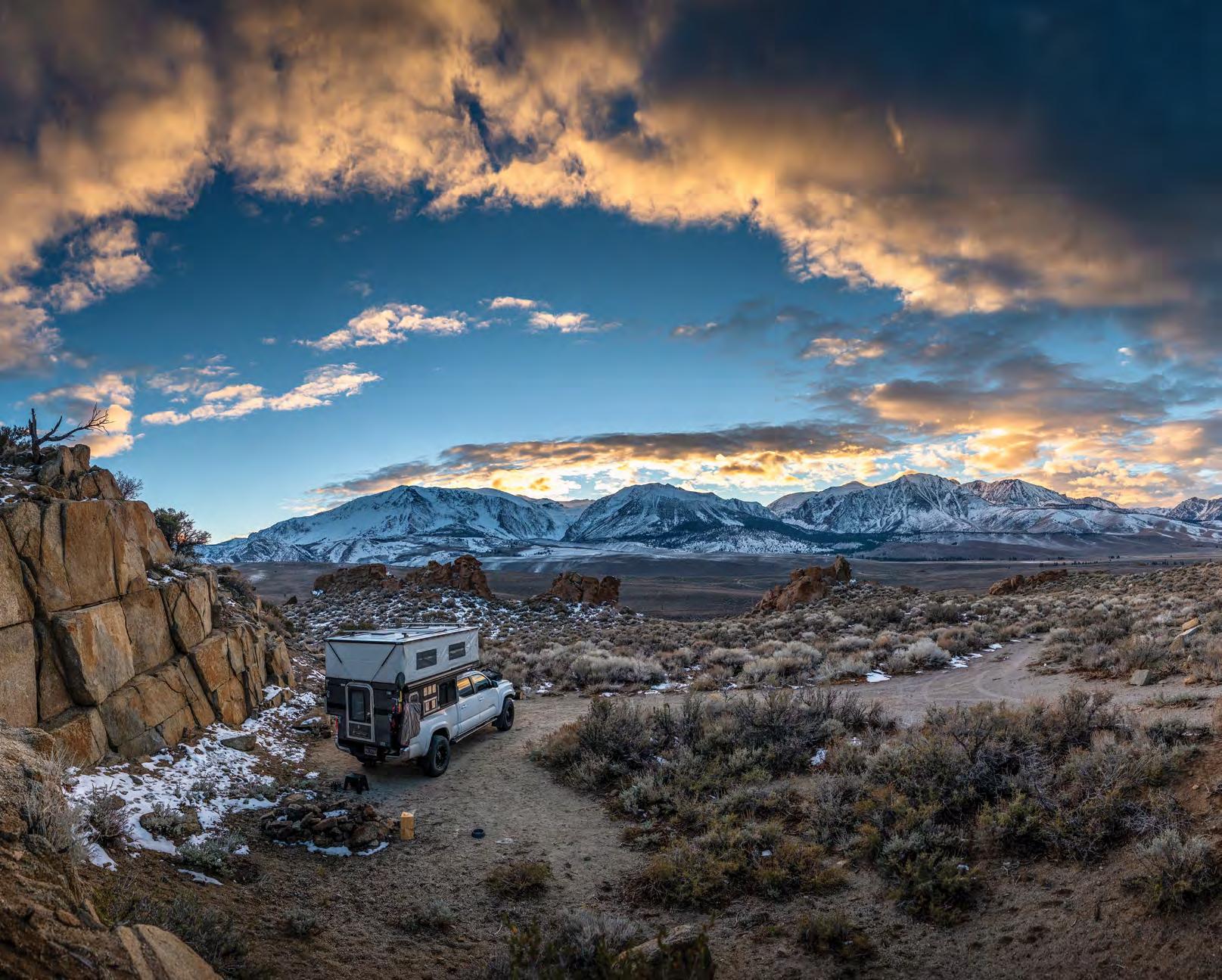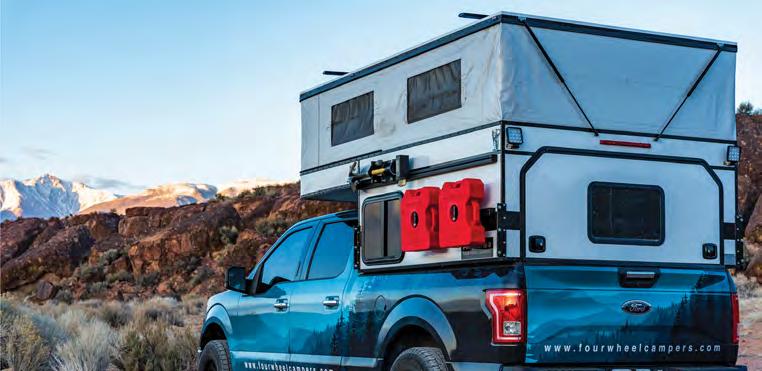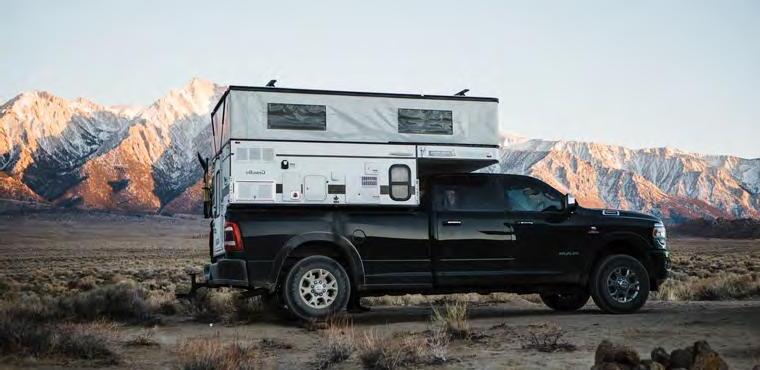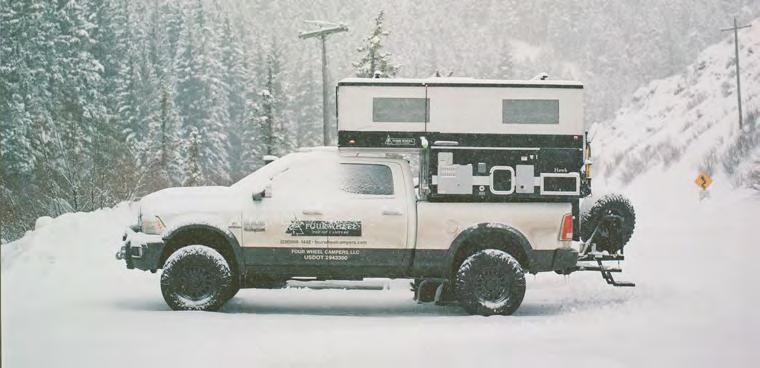








G r e a t a d v e n t u r e s h a p p e n n a t u r a l l y i n Tu o l u m n e C o u n t y. T h i s f a l l , r o a d t r i p y o u r w a y t h r o u g h t h e e p i c g r a n d e u r o f Yo s e m i t e , t h e h i s t o r i c t o w n s o f C a l i f o r n i a G o l d C o u n t r y a n d t h e m a j e s t i c b e a u t y o f t h e H i g h S i e r r a . H i k i n g , k a y a k i n g , s h o p p i n g a n d e x p l o r i n g g r e a t f o o d a r e j u s t a h a n d f u l o f t h e a d v e n t u r e s y o u c a n f i n d h e r e W a n d e r f r e e l y a n d p l a n y o u r t r i p t o d a y. VisitTCToday.com/AdventureSports
Great adventures happen naturally in Tuolumne County. This fall, road trip your way through the epic grandeur of Yosemite, the historic towns of California Gold Country and the majestic beauty of the High Sierra. Hiking, kayaking, shopping and exploring great food are just a handful of the adventures you can find here. Wander freely and plan your trip today.

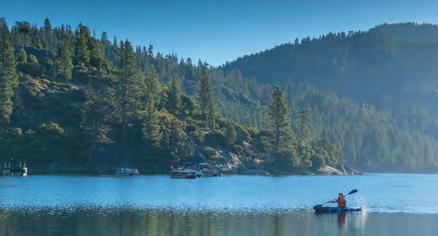





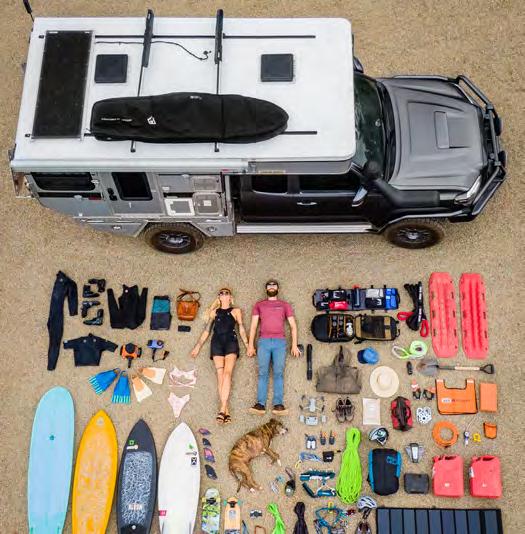

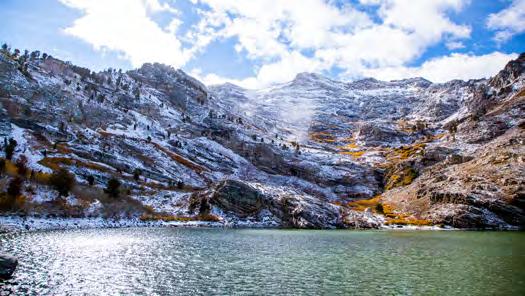
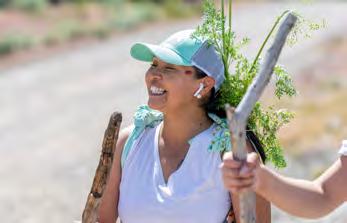


PUBLISHING + EDITORIAL
PUBLISHER

Cathy Claesson cathy@adventuresportsjournal.com
EDITOR-IN-CHIEF
Matt Niswonger matt@adventuresportsjournal.com
EDITOR
Michele Lamelin michele@adventuresportsjournal.com
COPY EDITOR
Jennifer Stein jen@adventuresportsjournal.com
SOCIAL MEDIA MANAGER
Marissa Neely marissa@asjmag.com
CONTRIBUTING PHOTOGRAPHERS
Sydney Martinez, David Bunker, Larry Burton, TravelNevada, Jessica O’Bryan, Travis Burke, Eric Whitaker, Jeana Miller, Paul Ryan, Anthony Cupaiuolo / First Tracks Productions, Rebecca Byerly / Women of the Mountain, Matt Johanson, James Murren, Thomas Greene, Hannah Fleetwood, Chris Van Leuven, Mollie Moran, Will Truettner
LAYOUT
Cathy Claesson
COVER DESIGN
Lauren Worth

Are you a nomad at heart? Why or why not?
leoniesherman
I’ve slept in my own bed maybe 25 nights out of the past 200. Exploring new places and reconnecting with old friends keeps me sane during these crazy times — but I’ve been rambling for 30 years, so …
Yes, I suppose I always have been a nomad. In fact, this question caught me on the summit of Grizzly Peak in Shasta National Forest, hiking the PCT.
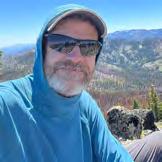
chrisvanleuven
Yes, though I’ve had my roots firmly down in Mariposa, but now that my house burned down in the Oak Fire anything is possible.
Yes, I am a nomad at heart, but at the age of 83, I spend most of my time in Bozeman and my nomadic heart and mind are amply fulfilled on my zafu at the Zen Center.

ADVERTISING
ACCOUNT EXECUTIVE


Cathy Claesson I 831.234.0351 cathy@adventuresportsjournal.com

EVENTS & DISTRIBUTION
Matt Niswonger matt@adventuresportsjournal.com


EVENTS MARKETING
Michele Lamelin michele@adventuresportsjournal.com

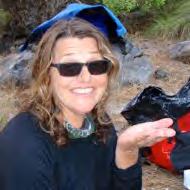

Jennifer Stein jen@adventuresportsjournal.com
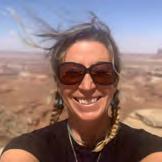
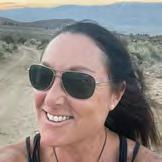
Opinions expressed are those of the authors and not necessarily those of Adventure Sports Journal or our advertisers. We usually agree with our articles, but sometimes we don’t. We welcome all contributions.

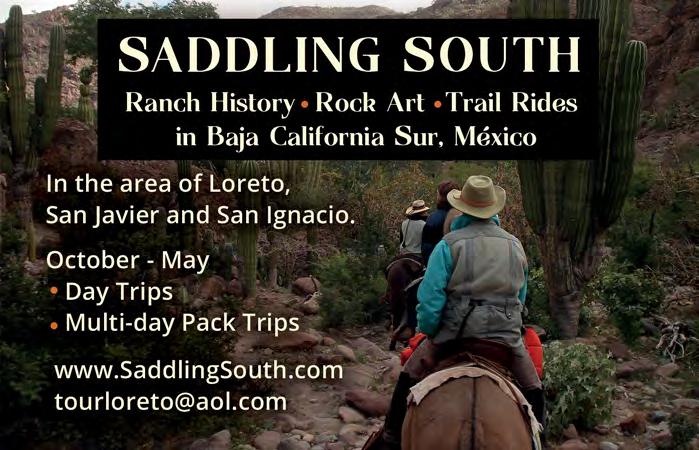
All content © Adventure Sports Journal 2022. No part of this publication may be reproduced without permission of the editors

ADVENTURE SPORTS JOURNAL

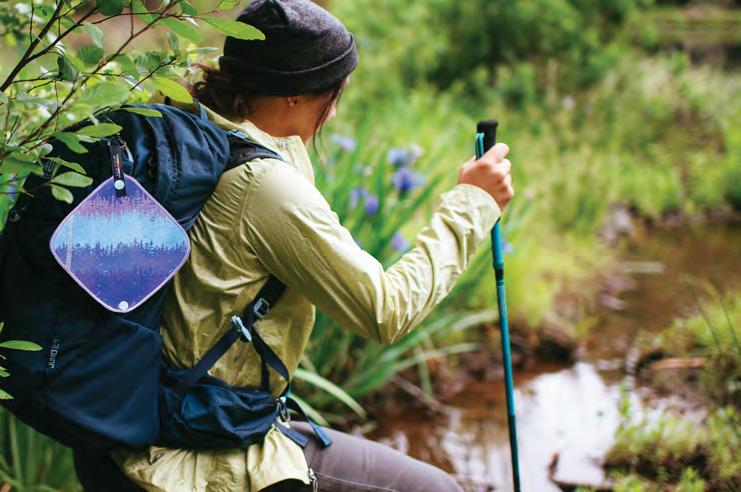
PO BOX 35, Santa Cruz, CA 95063 Phone 831.457.9453
No, but I am an adventurer at heart and love to fly the nest to satisfy that craving. But, there’s nothing better than coming home to a beautiful nest after a great trip outdoors.
I am an intellectual nomad, albeit a sloppy one. It keeps me moving in the physical world too.
I was for some 25+ years. Now, I’m a neighbor and community member, which is very satisfying. Nevertheless, I sometimes have to go ... anywhere/ somewhere!

I’m definitely a nomad at heart and am my happiest, best self when I’m traveling, but I’m continually drawn back to my home territory, the mountains of California’s Sierra Nevada.
The Original Antimicrobial Pee Cloth for all the places you ‘go.’
VISIT KULACLOTH.COM
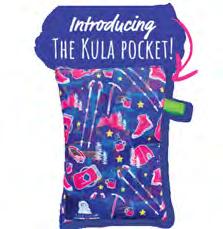
BAG

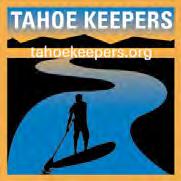
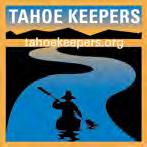

Reading through our last issue (#124) I was struck by a quote about Indigenous people. It was an article by Krista Houghton, about helping the Amah Mutsun Tribal Band stop a proposed gravel quarry on sacred land known as Juristac, near present day Gilroy in Santa Clara County. The Amah Mutsun are the descendants of survivors of the Santa Cruz and San Juan Bautista missions.
The quote was by marine biologist Greg Cotten, a long time advocate for the Amah Mutsun Tribal Band. “When we broke our relationship with the Indigenous people,” Cotten says, “we also broke our relationship with nature. Until we heal that wound, we will never heal our relationship with nature.”
Later that day, I came across the photo to the right. A friend of mine posted it on Facebook. It depicts a Native man being executed by a firing squad. It’s a haunting image that immediately reminded me of Cotten’s quote — especially the second part: “Until we heal that wound, we will never heal our relationship with nature.”
After doing a Google search, I learned that the historical details on the photo are murky. It was supposedly taken at Fort Stevenson in North Dakota between 1883 and 1890. It appears that Native residential school children are standing in a line, forced to watch while a Native man in traditional headdress is being executed.

Though the exact details of this photo are unknown, what we do know is that between the 1860s through the late 1970s, tens of thousands of Native children were forcibly taken from their parents and sent to boarding schools run by the US government. These boarding schools were designed to “civilize” Native children and were not outlawed until the passage of the 1978 Indian Child Welfare Act.
“Until we heal that wound, we will never heal our relationship with nature.” We live in a country that ripped thousands of Native children away from their parents. This was evil. This was insane.
I used to believe that history, while important, isn’t relevant for understanding ourselves as we move forward. I no longer believe that. Until we tell the truth about ourselves and our past, nothing fundamental will change. For Native Americans, the tragedy of residential schools is something they are still trying to process. It’s not our place to tell them to “just move on.”
We kidnapped Native children. We cut their hair, gave them new clothes and forbade them from using their own languages and names. They were not allowed to practice their religion. We said we were saving them but we actually were killing them. Many of them ran away. Many of them died of a broken heart. To this day, we are still finding the graves. Some are marked. Some are not. “When we broke our relationship with the Indigenous people, we also broke our relationship with nature. Until we heal that wound, we will never heal our relationship with nature.”
The photo of a Native man being executed is a metaphor for our collective estrangement from nature. We are killing nature just like we systematically tried to wipe out Indigenous populations all over the US and the
world. We are killing nature and forcing our children to watch. It’s evil. It’s insane.
Welcome to issue #125. On our cover is Kutoven Stevens, one of the fastest distance runners in the country. Known by his nickname “Ku,” he started a running event called The Remembrance Run to honor his grandfather Frank “Togo” Quinn, a residential school survivor of the Carson Indian School in Carson City. We will be there on August 13-14 to follow in his footsteps. Ku’s grandfather escaped from the Carson Indian School and ran 50 miles to his home on the Yerington Paiute Reservation when he was only eight years old. We will follow Ku, to honor this brave journey and what it represents for Ku’s family, for all Native Americans, and for our country as a whole.
We can restore our relationship with Native Americans while restoring our relationship with nature at the same time. The journey won’t be easy, but it will be transformative. We will use our power for good instead of evil. We will save nature. We will save ourselves. This is not about white people saving Native people. This is about white people facing up to our history so we can restore our integrity. This is about standing shoulder to shoulder with Native Americans and saving Mother Earth together.
Matt Niswonger matt@adventuresportsjournal.com
I like reading the physical copy of ASJ. You guys do such a great job! And I love that you are local and have stories about our state. I remember discovering Xtracycles through your magazine, and everyone was amazed at what I did to my bike. I am now reading your summer issue, and your story on packrafts has piqued my interest.
Thanks for the great magazine!
I am a long time ASJ reader and appreciate good writing. Though I’m not a poet, I really enjoy reading poetry. Have you ever thought of publishing nature based poetry in your publication? I think it could be a great addition to what you are already doing, and it is a way for readers to contribute a piece of art to your publication. Just a thought.
— Mike Kuimelis, NovatoWe love hearing from readers. Send us a note, or if inspired, send us a nature based poem for your chance to get published and receive $100 and two bottles of wine of your choice from Mantra Wines. Congratulations to our first winner, Anna Walters of Sebastopol for her poem Let It go to the Fury of the Winds Questions, comments, ideas? Drop us a line PO Box 35, Santa Cruz, CA 95062 or staff@ adventuresportsjournal.com
Went out on a drive today… Followed Third Street as far as it would go Before it ended and forced me
To take a hard left. I took Whatever that street was And cruised ‘til I came to The main highway.
I followed the signs
To Sebastopol, Occidental, and Bodega
I saw vast meadows
With old oak trees, lush Greenery of the coastal forest, smelled Sweet fresh earth and pine—
I wound my way further west
Until—at last—I reached the Bay. Pacific winds howled And bay waves chopped And crashed across the rocks below.
I got out of my car for a minute
To stand before the vastness of the ocean
And I felt her fury…
I bared the bittersweet chill of the gusting breeze
And suddenly threw my head back and heart out And allowed the wrath of the wild wind to rush over me And my body and spine bent back with it Arms open wide
I let my hair fly—in a brief ecstasy…
After a minute I returned To the warmth of the vehicle
To thaw. And quietly I wound my way back home.
— Anna Walters, SebastopolIN SANTA CLARA COUNTY
Tribal and environmental leaders have sounded the alarm about a proposal to develop an open-pit sand and gravel mine in Santa Clara County. The proposed development is on Juristac, lands that are sacred to the Amah Mutsun Tribal Band and vital for wildlife and the environmental health of the region. This intact landscape –also known as Sargent Ranch – is southwest of Gilroy.
A draft Environmental Impact Report (EIR) examining the impact of the mine, found that the project would cause significant and unavoidable impacts across at least six topics, including biological resources, cultural and tribal cultural resources, air quality, and transportation. The current landowner – the San Diego-based Debt Acquisition Company of America – are seeking permits for the mine. Amah Mutsun tribal members overlooking part of Juristac are trying to protect this sacred land.
“Juristac is the heart of Amah Mutsun spirituality and culture, and an openpit sand and gravel mine would forever desecrate this sacred place,” said Valentin Lopez, Chairman of the Amah Mutsun Tribal Band. “This mining project represents a continuation of the destruction and domination that our Amah Mutsun people have suffered for generations. The cultural survival of our tribe is at stake.”
To learn more and how to get involved go to asjmag.com/stop-sargent-quarry
As we go to press, the Oak Fire is still burning in Mariposa — home to the newly opened Yosemite Climbing Museum, as well as our long time climbing contributor, Chris Van Leuven, who lost his home on the very first day of the fire.
Van Leuven had created a perfect, yet humble, life for himself in Mariposa. He has climbed in Yosemite for nearly 30 years and contributes to various publications, including Adventure Sports Journal, Outside, Men’s Journal, Alpinist and many more.
Over the past year, Van Leuven has shared his enthusiasm for e-biking with anyone he meets. He says, “It is the best way to explore Mariposa.” He even had extra bikes for guests. It was on his way home from a long ride with some clients when he saw a fire blazing over Buckingham Mountain, just a few short miles from his 430 square foot home. He immediately called in additional friends and rushed to get his dog Fenster and his belongings. “I moved so fast I forgot Fenster’s leash,” he told ASJ, “and when I went back to get the rest of my bikes and gear, I was too late to go back home. I got the word that the property had burned down a couple of hours later. “
At press time, over 18,000 acres have burned, 74 structures are destroyed including 41 homes, and over 3,000 people have been evacuated. The fire is at 32% containment. The people of Mariposa will need our support after the fire, so please visit and support the local businesses as soon as it is safe to do so.
Learn more at asjmag.com/oak-fire
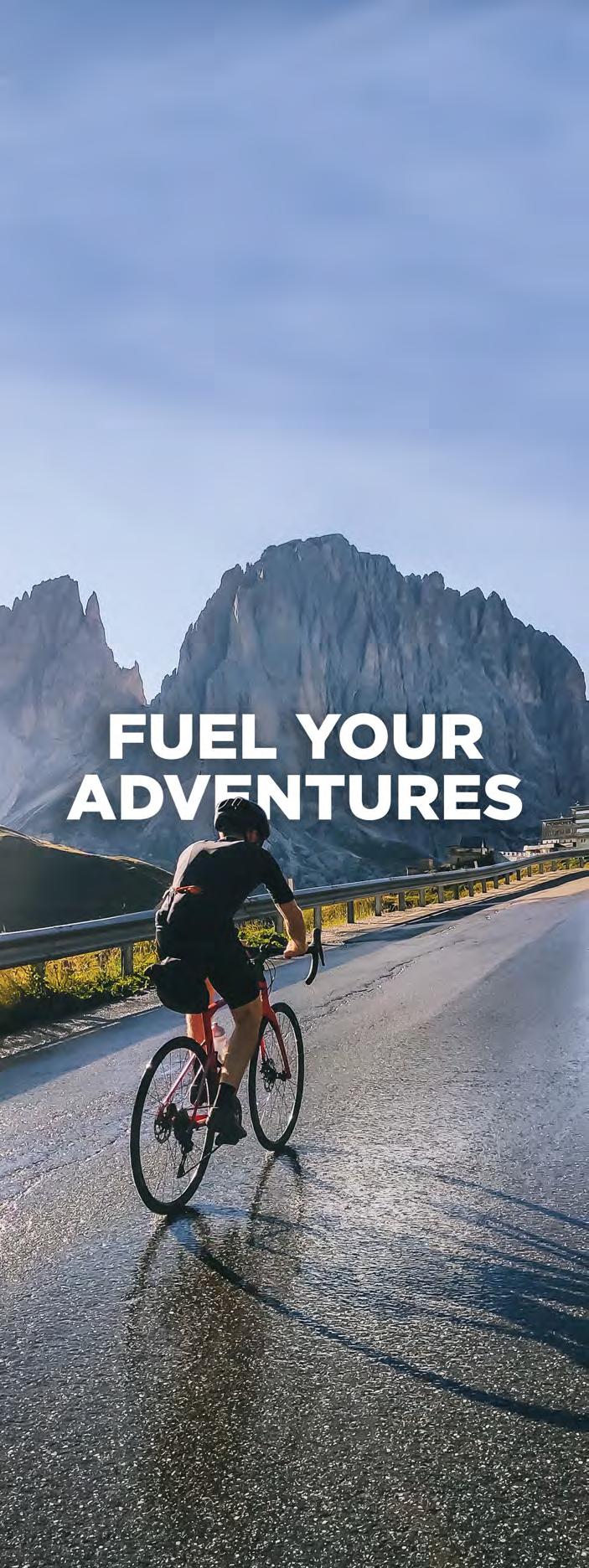
Feel good about what you fuel your body with.
JAMBAR® brings it with certified organic, clean and natural, real food energy handcrafted by the creator of the PowerBar®.
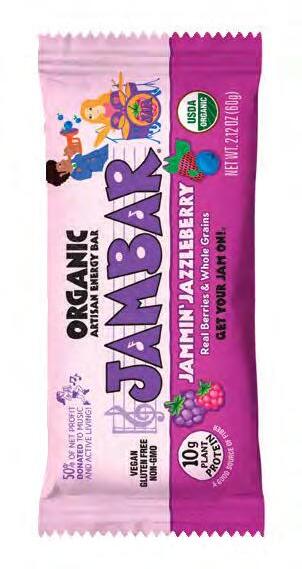

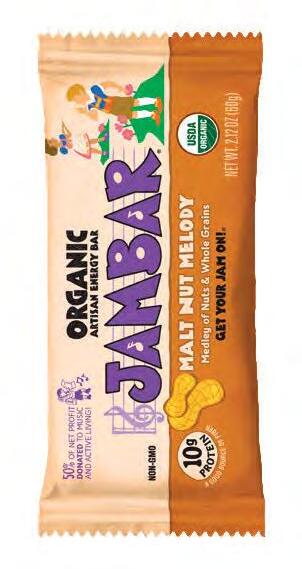
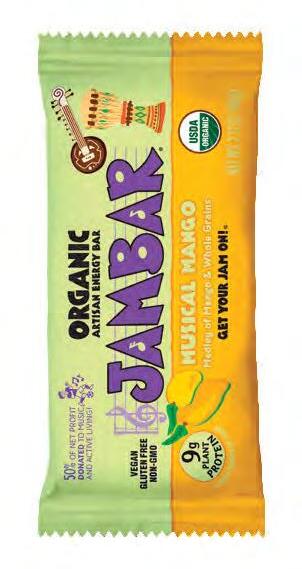
We’re talking superior, innovative ingredients unlike any found elsewhere. And, we support your community with 50% net profit donated to nonprofits that help others get their jam on. The perfect energy bar? Only one way to find out (while saving 15%). Use code JAM15
CERTIFIED ORGANIC. VEGAN & GLUTEN-FREE OPTIONS. NON-GMO.
JAMBAR.com
To recognize this year’s 30th anniversary of Monterey Bay National Marine Sanctuary, the annual Sea Stars Brunch is shifting to a formal evening Gala — not to be missed! Up to 500 guests are expected at the Sea Stars Gala on Sept 17th, 2022, and will include movie stars, politicians, award-winning musicians, photographers, filmmakers, and the who’s who of marine conservation.
The program will consist of presentations to the 2022 Sea Stars in Research, Resource Protection, Education and Outreach, Business/ Recreation/Tourism, and the overall Panetta Sea Star. It will also include talks from Secretary Leon Panetta and the esteemed board of directors, the premiere of the teaser short film about the history of the Sanctuary, and a special presentation from Frans Lanting (National Geographic photographer.) Along with the memorable program, the evening will include dinner, drinks, auctions, followed by live music and dancing.
All proceeds from the Sea Stars Gala will support critical wildlife protection and educational programs for Monterey Bay National Marine Sanctuary.
Learn more at asjmag.com/sea-stars-gala
With higher trail usage in the Tahoe region, many of the existing trails are being loved to death. The Tahoe Fund is hoping to help solve this issue through its Tahoe Trails Endowment. The nonprofit recently awarded $45,000 in grants from the endowment to the Tahoe Rim Trail Association (TRTA) and the Tahoe Area Mountain Biking Association (TAMBA) to support trailwork on popular trails in the Tahoe Basin.
The TRTA’s Trail Segment Improvement Program was launched this summer to provide preventative maintenance on the 200mile Tahoe Rim Trail. “This iconic trail gains in popularity every year, and as more people use it, it requires more continuous care,” said Morgan Steele, Executive Director, TRTA.
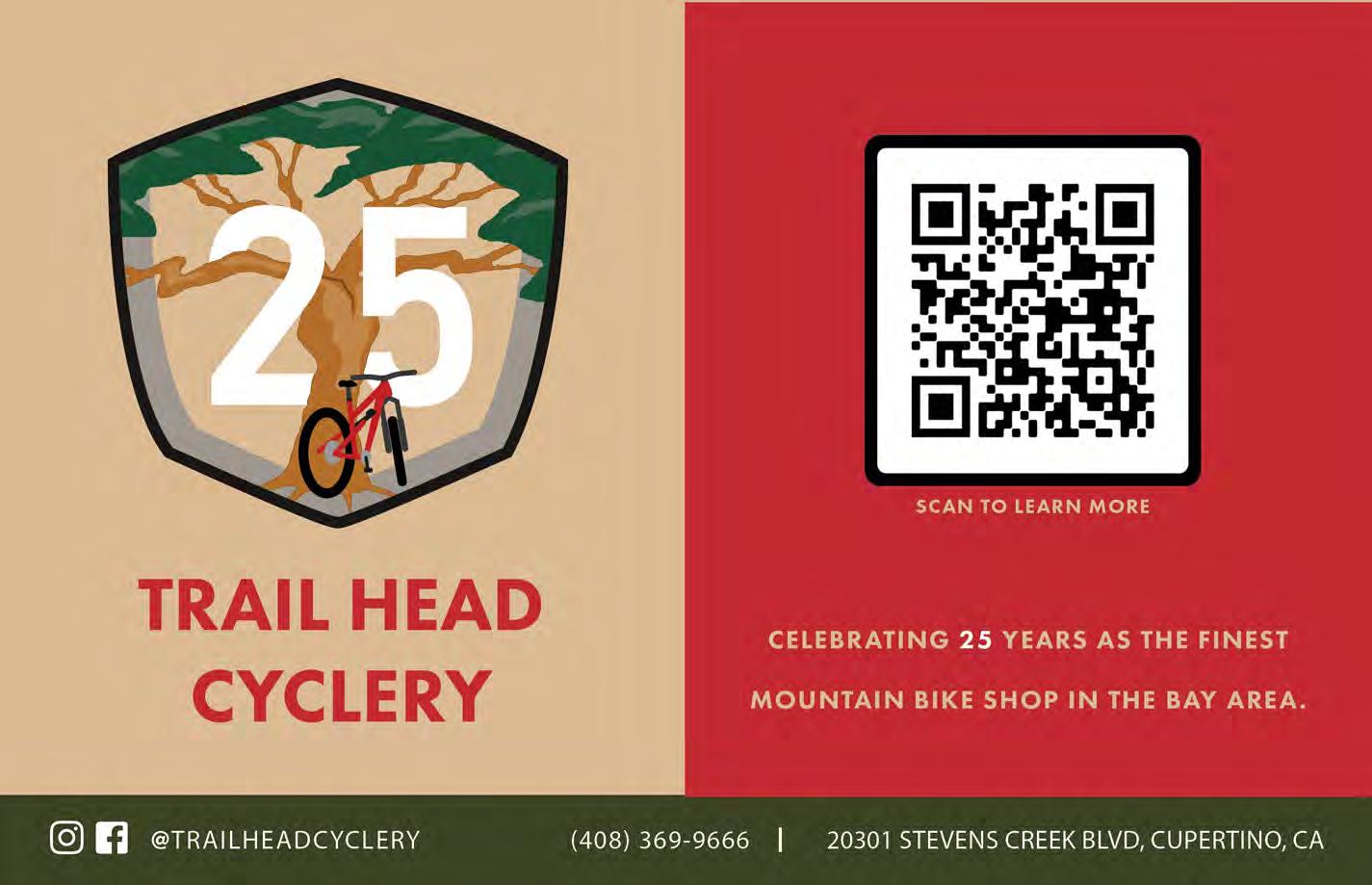
TAMBA was the first grant recipient in 2021 and that funding was instrumental in helping the organization quickly repair trails after the Caldor Fire. TAMBA is on track to perform maintenance on over 100 miles of trail in 2022.
Established as a way to address the longterm needs of Tahoe’s growing trail network, the Tahoe Fund hopes to grow the Tahoe Trails Endowment to $3 million to fund annual trail maintenance throughout the region. Currently, the endowment is at just over $1 million.
While building the endowment, the Tahoe Fund continues its work with key partners to develop a Trails Master Plan that outlines priority ranking for trail work. Learn more at asjmag.com/tahoetrail-fund
A proposed adventure park and surf park is coming to the Bay Area. City of Gilroy’s request to propose, develop, and operate a recreational tourism-based project on 536 acres owned by the City of Gilroy has brought a company called Select Contracts to the table, and before the year ends the Gilroy City Council will have a recommendation to approve an Exclusive Negotiating Agreement with Select Contracts.
The project is located at the gateway of the scenic Hecker Pass Highway (State Route 152) on the City’s western boundary. “The inclusion of a full-scale lift accessed downhill bike park within a day-trip of the Bay area and weekend trip distance for much of the central California coastline is totally unique and compelling as its own offering,” said Select Contracts in their proposal to the City.
The park would be a resource for local high school mountain bike teams, mountain bike enthusiasts, new riders, hikers, and those who enjoy emerging trends in recreation. There is not another project like this in the region.
In addition to biking and hiking opportunites, there is a proposed zip line course, ropes course, surf pool and wave pool. Accomodations, rentals and retail will also be available for folks who are coming from out out of town or don’t have their own gear. The public will be included in the entire process, so check out the City of Gilroy’s website regularly for up-to-date information.
Learn more at asjmag.com/adventure-park.
The Biden-Harris administration recently announced that the Department of the Interior’s U.S. Fish and Wildlife Service has awarded $3.4 million in funding from President Biden’s Bipartisan Infrastructure Law for cooperative agreements with the Washoe Tribe of California and Nevada and the Tahoe Regional Planning Agency to combat the spread of aquatic invasive species in Lake Tahoe.
The funding will support efforts to remove the Eurasian watermilfoil — a pernicious aquatic invasive plant — as well as funding for public outreach and education about aquatic invasive species, and investments in permanent inspection stations.
“Our ongoing collaboration with Tribal leaders and local partners is crucial to successful implementation of President Biden’s Bipartisan Infrastructure Law,” said Service Director Martha Williams.
Lake Tahoe holds significant cultural importance for the Washoe Tribe and is part of the historic range of Lahontan cutthroat trout. The Washoe Environmental Protection Department was established in 1998 and has been a key partner in ongoing restoration work. Several projects have been identified that will increase Tribal engagement and participation in ecosystem restoration efforts and inform future program priorities with traditional perspective and methods.
Learn more at asjmag.com/bipartisaninfrastructure-law
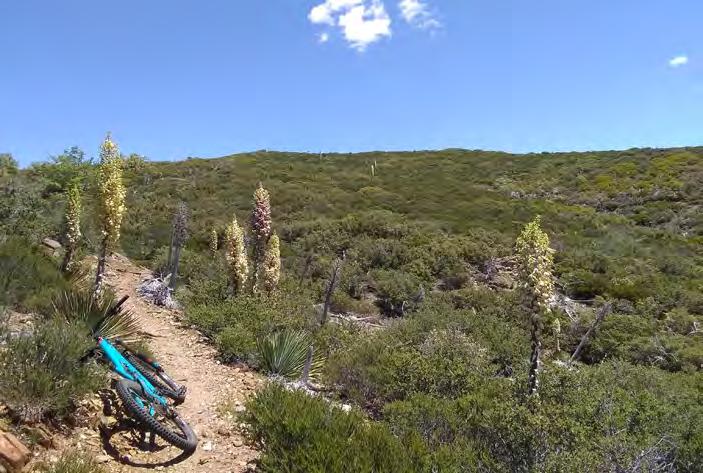 By James Murren
By James Murren



Noble Canyon National Recreation Trail in east county San Diego is ten miles long from top to bottom. You can hike it, bike it, run it, and horseback ride it. While doing so, you’ll pass through some six eco-zones, ranging from pine forested slopes to a breathtakingly beautiful oak grove, complete with a mountain stream from winter through late spring/early summer, the trail then stretching into desert land with cacti, succulents and chaparral. For mountain bikers, it is an IMBA Epic and one of the top adventure rides in Southern California. There are many ways to ride Noble, including the use of a shuttle, if you set it up.
To turn it into a longer ride, I like to link it up this way: Park at the trailhead in Pine Valley > Climb up the old Pine Creek Road > Stay straight at the big tree up top and continue on the dirt Deer Park Road > Turn right at Indian Creek Trail and climb up to Champagne Pass > Go left on Pine Mountain Trail > Turn right at Sunrise Highway/Pioneer Mail and ride to Penny Pines Trailhead > Hop on Noble Canyon Trail and ride it all the way back down to where I parked my car.
A few notes: You need an Adventure Pass for parking at the Noble Canyon Trailhead in Pine Valley because it sits


in Cleveland National Forest. You can get a pass at the gas station in Pine Valley town. If you have a National Parks pass, that works too. Pack plenty of water and food, and then pack a little more hydration. There is a hand pump/water at Penny Pines, which is used by PCT thru-hikers. You cannot count on this, though, as I have been there when it has been turned off. If the water’s turned on, top off your bottle/hydration pack.
Highlights: Indian Creek Trail and across to Pioneer Mail on Pine Mountain Trail is my favorite stretch of single track in San Diego County. It feels remote, has some tech sections, and affords vast views of the Laguna and Cuyamaca Mountains. Noble in late spring/early summer pops with wildflowers and I especially love when the yuccas are flowering. The oak grove in the middle of Noble is a favorite spot to stop and eat. Think Tolkien.
If you ask anyone to name the top five family brewers in San Diego, the Mcilhenney family in Alpine, CA will be on everyone’s list. They are masters at crafting West Coast IPAs. Back at it in their original location in town for a year now, they are also canning some of their beers. Stop in, have a pint and pick up a 4-pack. I recommend their rendition of a Nelson-hopped, rye IPA called Muntz (7.2% ABV). It is quintessential Mcilhenney Brewing Company. Their 1-year Anniversary triple IPA called Higher Times came in at 11%. I had it as a late evening summer sipper that tasted like sunshine-infused tangerine flowers with drops of melon-touched honeysuckle breezes all landing milliseconds apart on my palate the way orange blossoms flutter to the ground on a windy day (not really … I’m simply poking a little fun at some beer descriptions these days). Cheers!
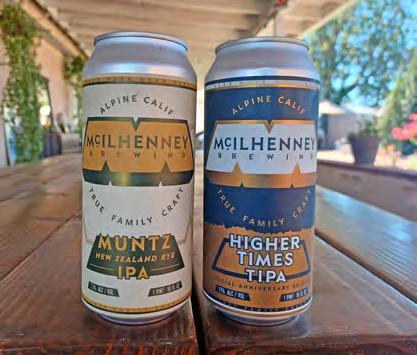
mcilhenneybrewing.com

Fun is happening at full speed at Mammoth Bike Park. Cool temperatures and massive early summer trail maintenance means increased flow and a ton more fun. Ride any 4 days this season for less than $44/day, no blackout dates, with the Quad Pack.
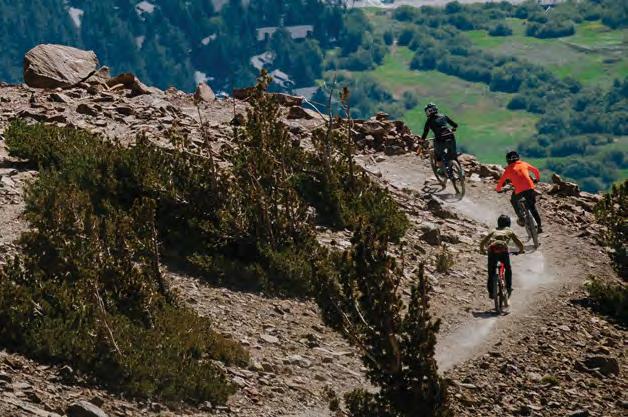
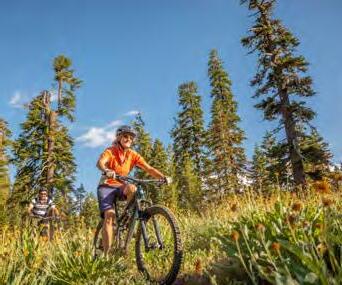

I’m on the eighth day of a twenty-five day backpacking trip, climbing a rocky mountain pass in California’s Sierra Nevada. I’m hot and tired but also full of joy. As I look out toward the vast range of light, I’m full of gratitude for the body that got me here and my past decisions that have enabled me to choose to live the life I had always imagined. It’s no coincidence that the words of two male explorers and nature writers, Muir and Thoreau, are in my head, for the outdoors has historically been occupied by men, with women mostly relegated to domestic spheres, rearing and raising children. I’m 51 and my life’s path was made possible by remaining childfree by choice — a decision every woman should be able to make for herself. I want to tell you my story because secrecy breeds shame, and there’s nothing shameful about making the best possible choices for ourselves.
My life would be very different had I been forced to go through with the pregnancy I terminated nearly 30 years ago. It would not have been possible for me to live the life that has brought me so much happiness, and to make meaningful contributions to the world by teaching and mentoring other writers — if the right to a safe and legal abortion hadn’t been available to me when I needed one.
I was 24 and swirling in a well of grief because my father — still Daddy to me — had just died. I started dating a man from my graduate program: an older man and an artist. A writer with a sharp intellect who drank too much whiskey and shouted at me. In all of these ways, he was similar to my father. But in some ways, he wasn’t like my father at all. He asked me why I thought I was so special and made sure I knew he didn’t think I was. We broke up and got back together so many times my friends started calling him my on-again-offagain. He was having sex with another
woman, but he denied it, calling me crazy for asking (I would later learn the term for this behavior — gaslighting). I put up with this because I was young and had so little regard for myself. I couldn’t see past my grief.

I got pregnant around the same time as my on-again-off-again’s other woman. I may have lacked self-confidence, but I also knew if I didn’t terminate the pregnancy, I would be tied to him (and possibly her) for the rest of my life.
I was young and poor and would have to drop out of graduate school. My father died with a mountain of debt, and my mother still worked in retail and didn’t have the means to help me raise a child.
Though I had it better than most, I was a first-generation college graduate, and although I could imagine my life’s trajectory, my situation was tenuous at best. My on-again-off-again had been adopted and made it clear that was the only option he wouldn’t agree to. And in truth, I wouldn’t have been able to do
that either. I do not see an embryo or a fetus as a baby, so having an abortion is not the same as giving away a fully formed little person. And if not being able to give my child away is some moral failing on my part, so be it. But also, there’s this, which is as important to the story as anything else. Right before Daddy died, I had just returned from hiking California’s John Muir Trail. I hiked the trail with two other women, and while I was out there, I fell in love with the outdoors, specifically the Sierra Nevada. And being so in love with the mountain wilderness made it possible for me to extend a little bit of that love to myself. The body I had berated for being too big, too clumsy, too slow, became the body that carried me up and over mountain passes, through rushing creeks, across snowfields. Hiking through hail, the blazing sun, and lightning storms made me realize I could be afraid but still keep going. I could be uncomfortable and scared and tired, yet still keep putting one foot in front of the other. I felt
strong and free, and I wanted to write stories about it. In the outdoors, I am the best possible version of myself. And being a better person also means I’m a better citizen of my community and of the world.
Shortly after I found out I was pregnant, my on-again-off-again (now back on) and I were laying on his futon on the floor of his apartment, and I looked up at the window, out at the falling rain, feeling grief and confusion about my father and my situation. My on-again-off-again was sleeping off too much Bushmills. I was thinking about the almost-life inside of me.
The windowsill was full of dead moths, their dusty wings disintegrating, and it felt like a metaphor. I felt like if I went through with the pregnancy, the wings I was just beginning to form would turn to dust, too. I was young and poor and would have to drop out of graduate school. I wouldn’t be able to move to the mountains I so loved, to move freely
The author backpacking near her home in Lake Tahoe (Thomas Greene).

through them on my own terms. I would become a single mother, struggling the way all single parents do, with very little time to write the books I hoped to write. I likely wouldn’t even have the time to read a book. I would forever be tied to the man who was now drunksnoring next to me. I counted the years before a high school graduation, and one thing became clear: I didn’t want to be pregnant, I didn’t want a baby, and I didn’t want a child. I wanted to live a life of adventure and travel. I saw the future life I now live, and I needed it. These days, I’m glued to the news, and the circumstances for women around the country are more dire than my own pregnancy was. Some are unable to abort dangerous pregnancies, some are little girls forced to carry pregnancies resulting from rape and incest, some are now denied cancer treatment because the drugs might lead to a miscarriage. Everything is always in degrees, but every woman should have the ability to terminate a pregnancy for any reason. Not wishing to be pregnant is enough. In 1973 when Roe v. Wade passed, affirming the right to an abortion nationwide, I was just a baby. I grew up as a girl, and then a woman, believing I had autonomy over my own body, and I could choose to live the life I imagined. Having an abortion would keep the future I had envisioned for myself intact. I would choose an abortion to save my own life.

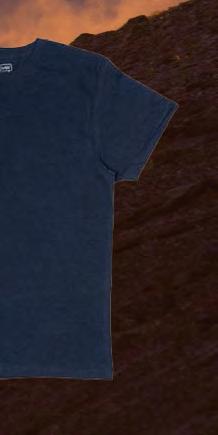
In the majority opinion overturning Roe v. Wade, Samuel Alito writes, “The



Constitution makes no reference to abortion, and no such right is implicitly protected by any constitutional provision ...” and that the right to an abortion is not “deeply rooted in history and tradition of our people.”
The Constitution was written in 1787 when women had virtually no rights; the Constitution also protected slavery and the slave trade. Although the US Constitution promises to “promote the general Welfare and secure the Blessing of Liberty to ourselves and our Posterity,” the original document was meant for only a certain segment of the population: white men. Now we are seeing our laws revert to protect only that population once again.
According to Alito, “Ordered liberty sets limits and defines the boundary between competing interests,” meaning that a potential life now has more rights than a pregnant person. Our general welfare and the blessings of liberty is contingent on our ability to choose whether or not (and when) we choose to carry pregnancies to term. While it’s true that some women have families in their pursuit of happiness, other women — like me — could not pursue the lives they are meant to live if they are forced to carry out unwanted pregnancies. And though motherhood was never my dream, it’s a dream in need of protecting, meaning


women should not have to carry out pregnancies before they are ready nor seek out dangerous abortions that could lead to infertility or death. The right to a safe and legal abortion is essential to women’s healthcare.
This is not about babies; it’s about controlling women, about forcing pregnancy and motherhood onto us so we assume our (proper) domestic roles. It does not seem to be mere coincidence that the post Roe v. Wade era brought many more women into the outdoors, including: the first woman to solo hike the Pacific Crest Trail, Carolyn “Ravensong” Burkhart (1976); Arlene Blum’s all-women ascent of Annapurna (1978); and the publication of the groundbreaking Woodswoman by Anne LaBastille (1976). And the irony of recent social media memes about safe places for abortion access referred to as “vacation” or “camping” is obvious enough. Camping, along with other
outdoor activities, is made harder, if not impossible, by forced pregnancy.



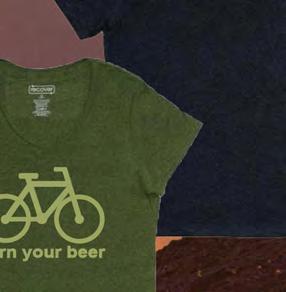
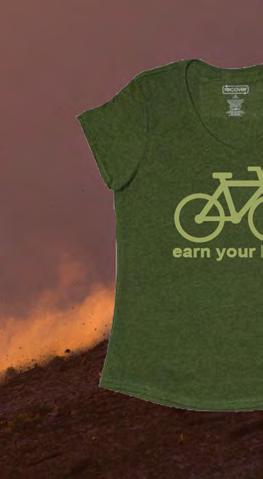
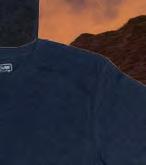

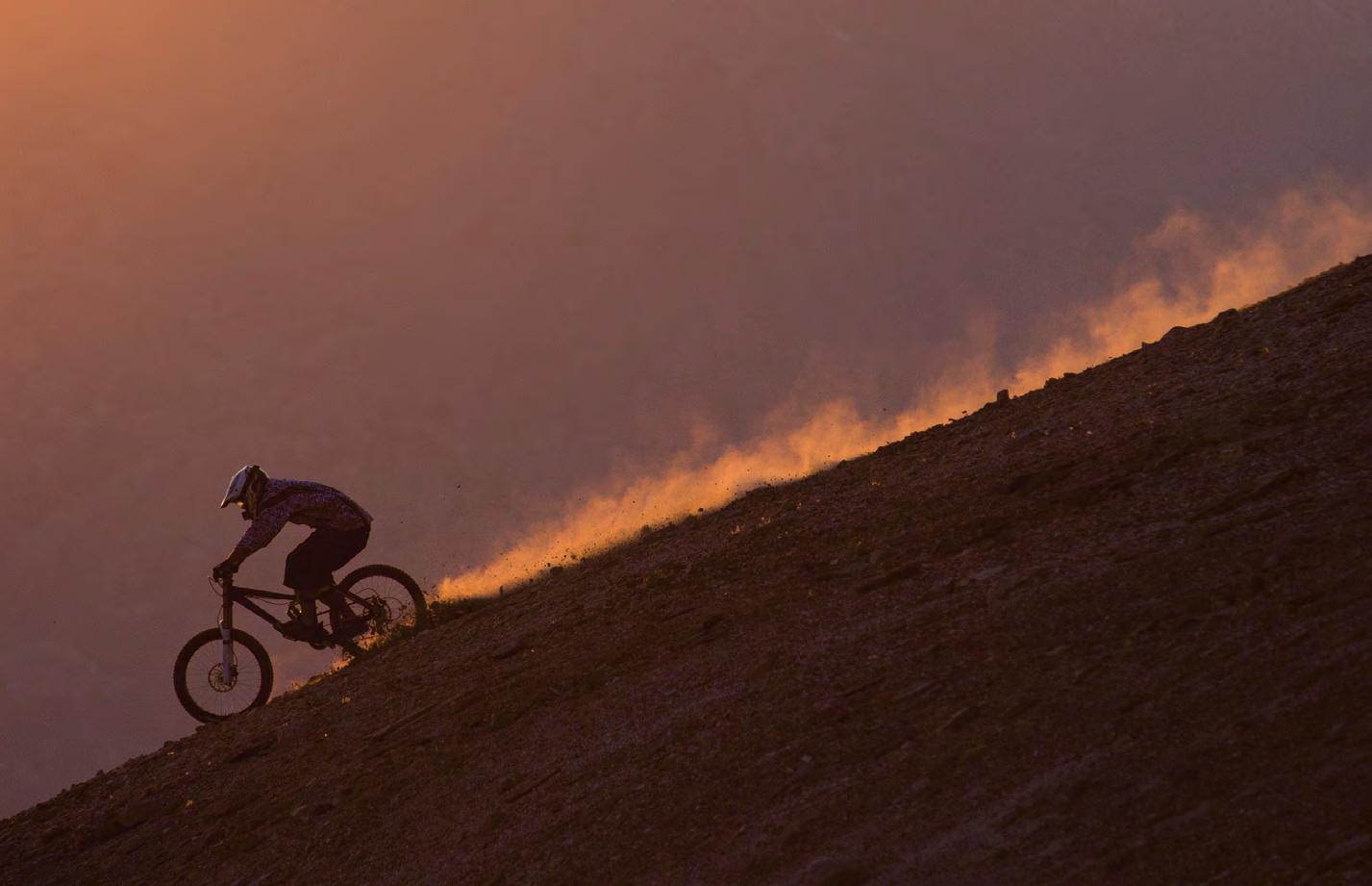
I do not regret the decision. We’re not supposed to say that having an abortion was the best choice we have made for ourselves; we are not supposed to say that our lives — the lives of girls and women — are more important than the almost-life of the fetus. And we are definitely not supposed to say that we would rather ski and hike and travel than raise children. And some women who enter into parenthood with loving partners or have tons of family support and resources can certainly do all of these things — but I wasn’t one of those women, and I’m grateful I had access to a safe and legal abortion, making it possible for me to choose the childfree life I wanted to live: one where I lace up my boots, head out the door, and follow a path through the woods alone.
Suzanne Roberts is the author of Almost Somewhere: Twenty-Eight Days on the John Muir Trail (Winner of the National Outdoor Book Award), Bad Tourist: Misadventures in Love and Travel, and Animal Bodies: On Death, Desire, and Other Difficulties. Roberts was named “The Next Great Travel Writer” by National Geographic’s Traveler and splits her time between South Lake Tahoe and a green van named Shrek. suzanneroberts.net
We’re not supposed to say that having an abortion was the best choice we have made for ourselves; we are not supposed to say that our lives — the lives of girls and women — are more important than the almost-life of the fetus. And we are definitely not supposed to say that we would rather ski and hike and travel than raise children.
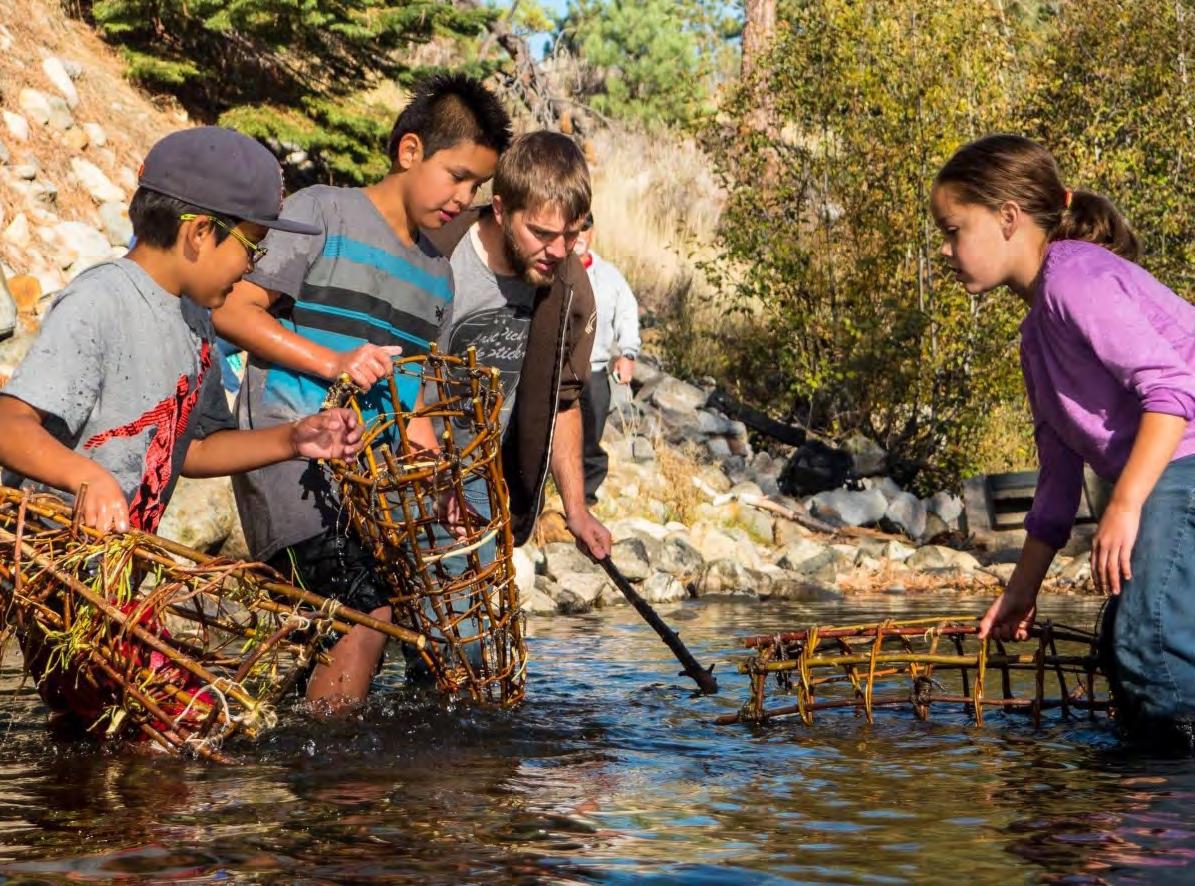 By Leonie Sherman
By Leonie Sherman
Every September, thousands of Kokanee salmon begin their arduous journey up Taylor Creek, at the south end of Lake Tahoe, to spawn. This freshwater version of sockeye salmon likely diverged from their ocean-going relatives about 15,000 years ago. For a month to six weeks every autumn, visitors from around the globe gather to gawk at the schools of silvery red fish, swimming upstream to lay their eggs. Some of those who gather are Washoe Native youth, armed with willow fish traps and homemade spears, whose ancestors fished this same creek, with those same tools, for millennia. The revitalization of traditional fishing is sponsored by the Washoe Tribe’s Cultural & Outdoor Expedition Program. The young folks joining are drawn by the programming, dedication and kindness of the tribe’s only probation officer, Paula Smith, who has revolutionized treatment for at-risk youth on the reservation.
Originally from Yerington Nevada, Smith is part Washoe and part Walker River Paiute. Her educational background is in Criminal Justice, but most of her work has been in Recreation. After working as a probation officer in Sacramento and Chief Deputy Probation Officer in Lyon County, she returned to her homeland in 2013 to do a repeat offender program with the Washoe tribe. “I always come back to Indian country because that’s where the help is most needed,” she says.
Her initial efforts to introduce new programming were met with resistance.
“When I asked if we can put in a culture, sports and outdoors component to the probation department, one chairman said ‘why do all the bad kids get to do the fun things?’” Smith sighs at the memory. “I had to explain that every kid on the reservation is at risk.”
“A big part of my work is changing language, changing how we think about this. Adults will say ‘oh, that kid is a trouble maker, they’re a problem kid,‘“ Smith says. “But really, what we need to figure out is what happened to that kid? Maybe they are acting out because they
got sexually assaulted, maybe they don’t want to go home because their dad is drunk and beating up their mom. We need to be asking kids ‘what happened, are you ok or how are you doing?’”

“My original position was as a probation officer,” Smith explains. “In the early years it was just really more of like a dictatorship, strictly supervision. I made sure they went to school, attended counseling, did their court orders. I was like reinforcement for the court. There was really no bonding, nothing about improving life skills or social skills or taking care of your body, exercising and eating right.“
Seven years ago she began to introduce cultural and outdoor programming to serve Washoe youth through a grant for juveniles. “Really this came about because the kids needed something more to do,” she says. “It was more outdoors than the cultural stuff at that point, just to get the kids out in the natural environment. We do everything from golfing, to hiking, to mountain biking, to ropes course, to white water rafting, and night hikes.” She also brings youth from different tribes together at community unity days and campouts.
These activities do more than expand the young people’s horizons and improve their health. “They form bonds and build camaraderie and learn team work,” Smith says. “Our programming covers life skills, nutrition, athletics, and academics, as well as bullying and suicide prevention.”
According to the National Council on Aging, the suicide rate among Native youth is 2.5 times higher than the national average for young people. “Some staff and kids don’t ever leave the reservation. My program is really trying to give these kids a wider experience. A lot of tribal youth don’t even have a parent to take care of them, a lot of them are taken care of by aunties and uncles, grandmas and great grandparents,” explains Smith. “Their parents are out partying, or in and out of jail. There’s a lack of supervision, kids need guidance, they just need some love and structure.”
Smith provides that love and structure. The Cultural and Outdoor Expedition Program she created meets five days a week from the beginning of June, when school ends, until the beginning of August when it starts
This page, top to bottom: Youth use traditional tools to fish for Kokanee salmon (Rebecca Byerly / Women of the Mountain); Paula Smith leads Carson youth in Tuolumne meadows hiking to Tenaya lake (Selfie). Opposite page, top to bottom: Mountain biking in Meeks meadow during a camp out at Meeks Bay (Anthony Cupaiuolo / First Track Productions); Snowboarding lessons at Palisades with a Share Winter
again. Smith gushes as she describes a recent week with the kids. “So Monday was Nevada beach at Lake Tahoe, Tuesday was the Science and Discovery museum, Wednesday was a cultural day, Thursday was fishing, Friday was Majestic Fall …”
Of course, she needs assistance to provide so many activities, and she’s not afraid to ask for it. “Before I started, there was a lack of collaboration, nobody communicated with each other,” Smith says. Now she works with
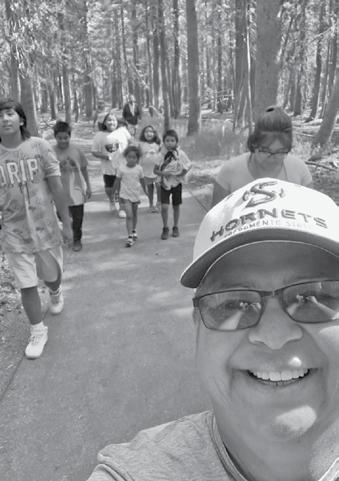
the Truancy Officer, the Education and Recreation Departments, the Healing Center and the tribal councils of each of the four Washoe colonies around a common goal. “We collaborate as a group to make all the programming,
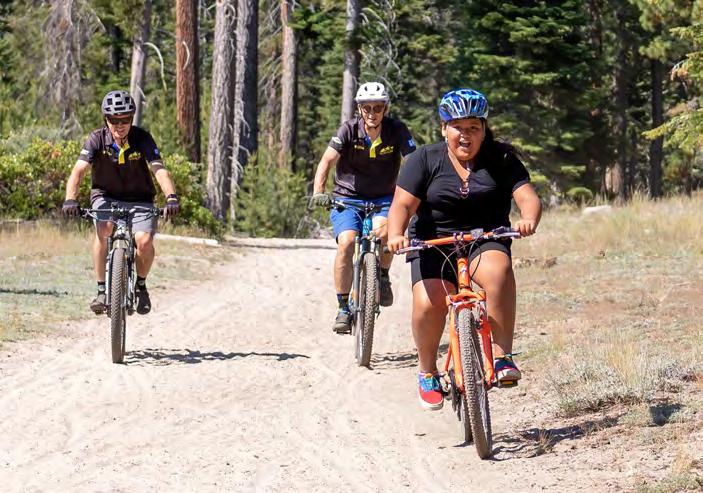

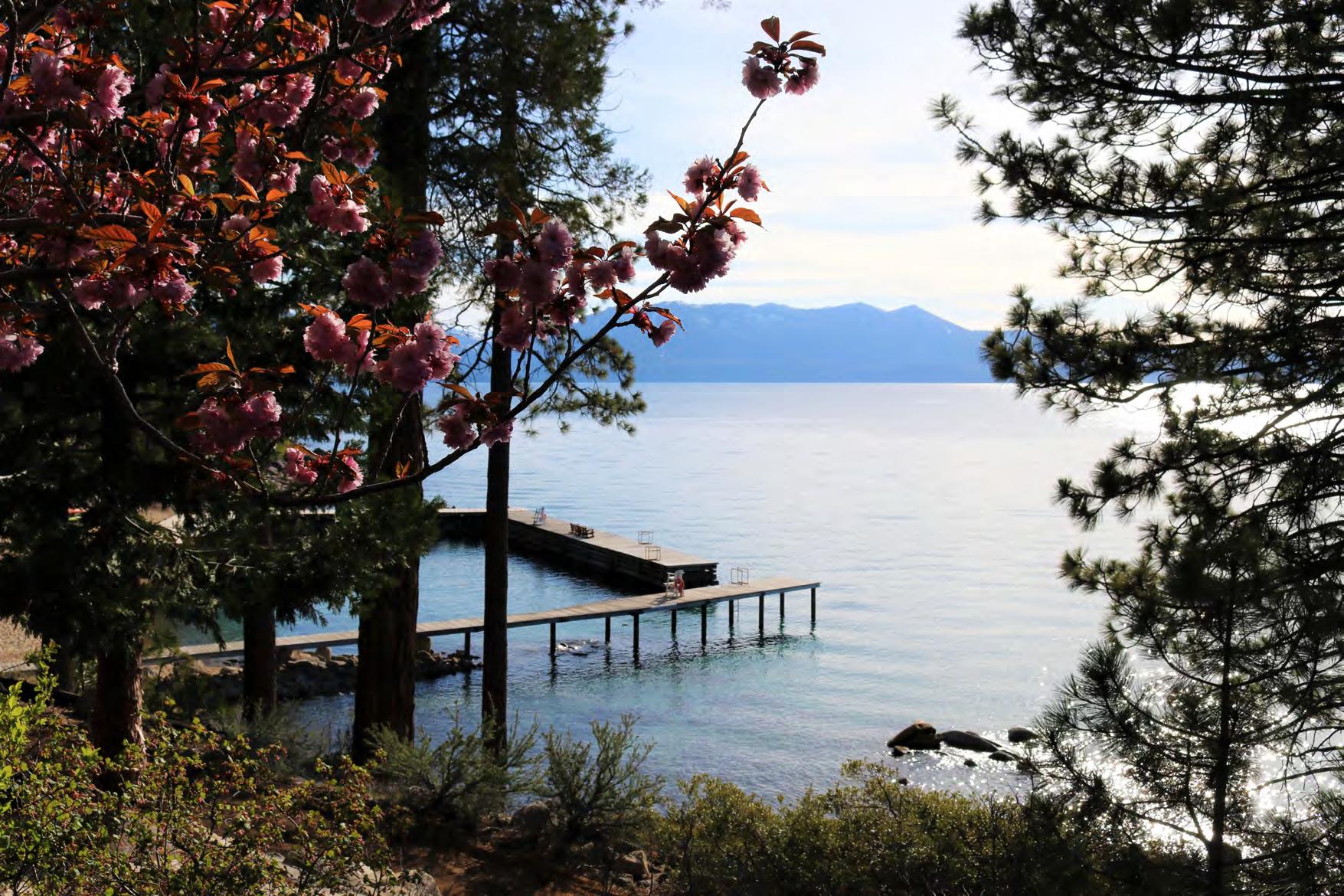
starting in March to build up for the summer.”
Every week is different, each day is unique. They might visit an amusement park, hike around a lake, play mini golf, visit a celebrity golf tournament to collect autographs, go to the movies, hike up Mt. Grant, swim in Weber reservoir or go mountain biking. Cultural exchange with other tribal groups, like the Walker River Paiute Tribe, helps create lifelong friendships and memories.
“When a kid catches their first fish it’s like the best day of their life,” explains Smith. “They never caught a fish before, just the excitement, you get five or six kids running over to see. The memories
“My program is really trying to give these kids wider experiences. A lot of tribal youth don’t even have a parent to take care of them, a lot of them are taken care of by aunties and uncles, grandmas and great grandparents.”
— Paula Smiththat we create for these kids impacts their entire life.”
Creating memories helps bring Native youth back to their heritage. “There’s so much history to bring back to the kids, helping get them involved with their culture and history,” Smith says. “Through our programming, we are remembering our ancestors and standing by our traditions, we are preserving our culture through these kids. They hike and fish in some of these same places where our ancestors hiked and fished.”
The Cultural and Outdoor Expedition Program serves 80–120 young people at a time. “Over the course of a year we are probably dealing with about 1,200 juveniles,” says Smith. “Most of the kids we have now are 8-18, but really they can be as young as 5. And some kids have come through the program and even after they’re 18 or 19 they don’t want to leave, so I let them participate as junior staff. They are positive role models for younger kids, it’s good for younger boys to see older males doing good stuff.
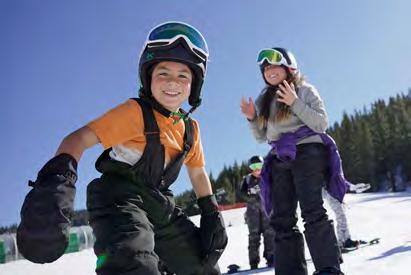
Though her title is Probation Officer, Smith explains that the mission of the juvenile probation department is to create cultural programming aimed at preventing juvenile delinquency. “It’s not just for probation kids, sometimes we want to defer youth from formal court proceedings whenever possible,” she says. “We are guiding youth towards broader perspectives and self discovery through adventures in the great outdoors.”
After a long career, Smith sometimes feels ready for rest, but the kids’ smiles keep bringing her back. “If it wasn’t for my summer programs I’d probably retire,” she admits. “These little native kids need this. Our program is something they look forward to every summer, and this might be the only good thing they have in their lives right now. Maybe they don’t feel safe at home because of drugs or alcohol or domestic violence, maybe there’s not a lot of food at home or they don’t even have shoes. For these at risk youth, we are creating a safe haven.”
To learn how you can support this work, email paula.smith@washoetribe.us
Arrow Canyon, Bird Spring, Bloody Run, Clan Alpine, Devils Hole, Flowery, Golden Gate, Goshute, Halfpint, Hog Ranch, Jumbled, Little High Rock, Medicine, Nightingale, Painted Point, Pancake, Pine Nut, Rawhide, Skull, Snake, Smoke Creek, Snowstorm, White Throne, Wild Horse. These are just two dozen of the over 300 named mountain ranges stretching across Nevada. There are an additional 100 unnamed ranges scattered across the desert and sagebrush.
Alaska has the highest point in the US, and Colorado has the highest mean elevation, but Nevada has the most mountains. And they’re not just hills; there are 172 peaks with over 2,000 feet of prominence. Boundary and Wheeler Peaks rise over 13,000 feet above sea level and 35 of Nevada’s summits are over 10,000 feet tall.
Nevada contains the heart of the Basin and Range Province, a vast region reaching from the Sierra Nevada to the Rocky Mountains, from southern Oregon to northern Mexico. Born 17 million years ago, the area is characterized by dramatic elevation changes as the land alternates between narrow north-south trending ranges and arid sagebrush flats. The isolated ranges create “sky islands” of endemic plants and animals.
Over three million people call the Silver State home, but almost 90% of them live in the state’s two main metropolitan areas. That leaves about three people per square mile in the rest of Nevada’s windswept wild lands, one of the lowest population densities in the lower 48. Although Nevada is home to Great Basin National Park, a part of Death Valley National Park, and three National Monuments, most of the state is public land.
I used to think of Nevada as 400 miles of dull between the better known scenic wonders of California and Utah. But while California and Utah adventurers compete for permits and get hassled by law enforcement, an intrepid Nevada explorer is almost guaranteed solitude and freedom. On the other hand, nobody’s coming to rescue you and there’s little cell service, so plan accordingly.
While summers in Nevada can top 120 degrees and winters drop to an average low of about 20, spring is a tug of war between the two, and autumn brings stable mild weather. Dying plants stain alpine meadows with russet and ochre hues, sunny aspen leaves sway in the wind and the vast cerulean dome of sky looms overhead. This is the time for a Nevada road trip. I chose the Ruby Mountains, East Humboldt and Toiyabe Ranges for a sampler of Nevada’s alpine wonders.
Spectacular alpine scenery and easy access make the Ruby Mountains Nevada’s most popular range. Nestled into the state’s northeast corner, just south of Elko, the Rubies feature deep cirques, hanging valleys, craggy peaks and glacier carved valleys. Most people head for Lamoille Canyon, where they

enjoy steep polished walls, alpine meadows, rushing streams and several well maintained trails. Snow may linger in sheltered patches throughout the year.
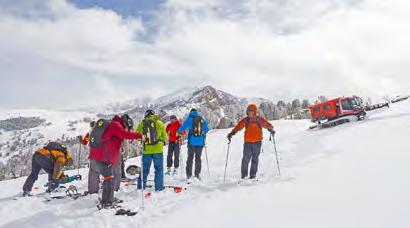
The smaller northern section of the range is accessible by a rough dirt road; hardly anyone goes there. High lakes, lonesome trailheads and a handful of jagged peaks are the major draw. Much of the backcountry in this area is windswept tundra, whose stunted plants become a somber impressionist display of burnished tints every autumn.
Pacific Northwest storms often miss California and most of Nevada, but bring moisture to the Ruby Mountains. Predictably, most of the precipitation arrives as winter snow. The skiing is so exceptional that Voile named a ski after the range; their founder claims the Ruby Mountains have the best powder on earth. Helicopter and snowcat assisted skiing are popular, but some diehards still trek in under their own power.
The Rubies boast Nevada’s largest mule deer herds, along with bobcats, mountain lions, antelope and bighorn sheep. Their high barren slopes and year round snowfields host the Himalayan Snowcock, an enormous grouse native to Pakistan introduced in the 1960s as a

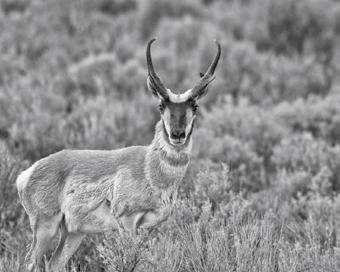
This page, top to bottom: The road to Angel Lake in the Ruby Mountains (Sydney Martinez/ TravelNevada); Skiers enjoy snowcat and helicopter skiing in the Ruby Mountains — some say the Rubies have the best powder on earth (David Bunker/TravelNevada); An antelope in the Rubies (BLM Nevada). Opposite page, top to bottom: Angel Lake is accessible by road and is the recreational hub of the East Humboldt Range (Sydney Martinez/ TravelNevada); Liberty Lake in Lamoille Canyon of the Ruby Mountains (Sydney Martinez/TravelNevada).
game bird. Birders and hunters treasure a sighting. Several hundred are thriving in the harsh Ruby Mountains; some have moved slightly north and east to the East Humboldt Range.
The recreational hub of the East Humboldt Range is Angel Lake, accessible by paved road, and near two full service campgrounds. The lake sits at just over 8,300 feet, with Greys Peak rising 2,300 feet above its placid waters. The slopes leading to its summit are lush green in summer and have swaths of glowing yellow aspens each autumn.
A compact range, just 30 miles long, the highest peak in the East Humboldt Range is over 11,000 feet; most of the
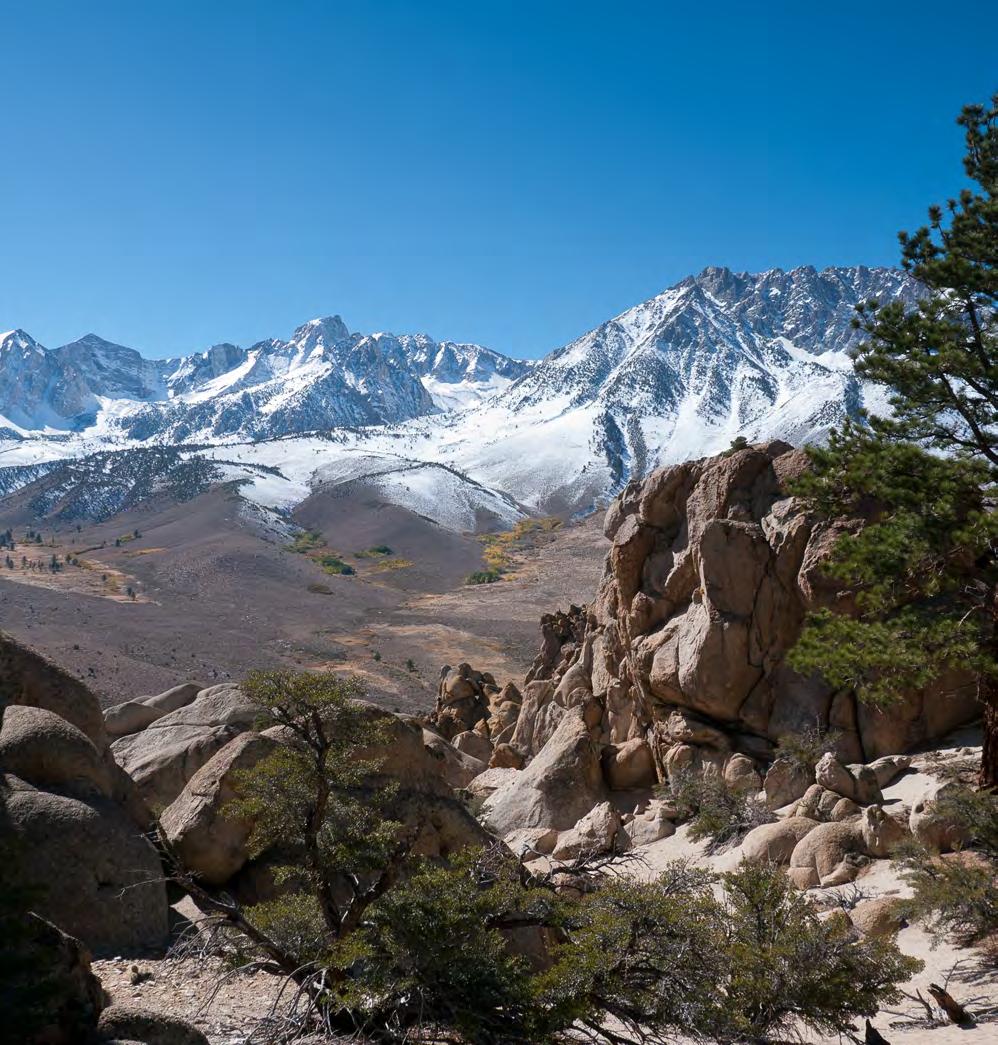




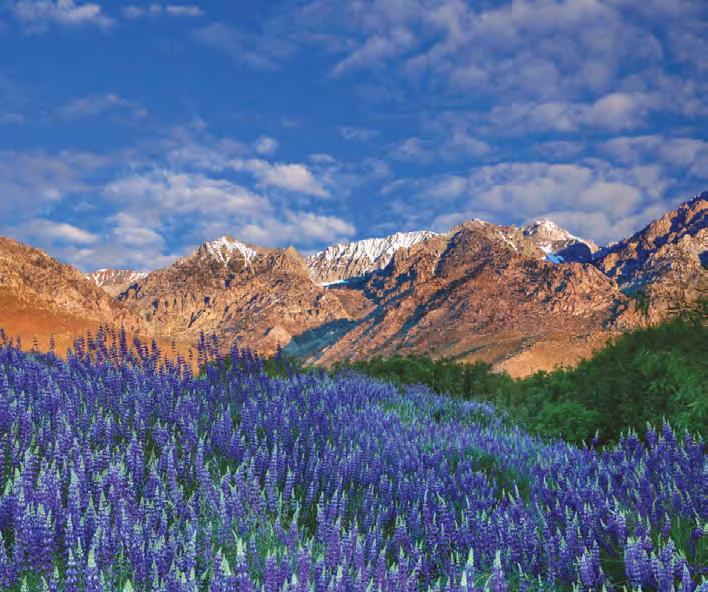
crest is over 10,000 feet. Winchell, Smith and Greys Lake are all lovely secluded hiking destinations, though sparse use and poor maintenance has left the trails in poor condition and occasionally hard to follow.
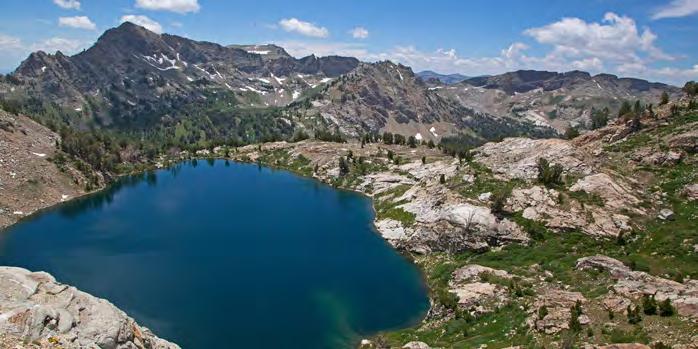
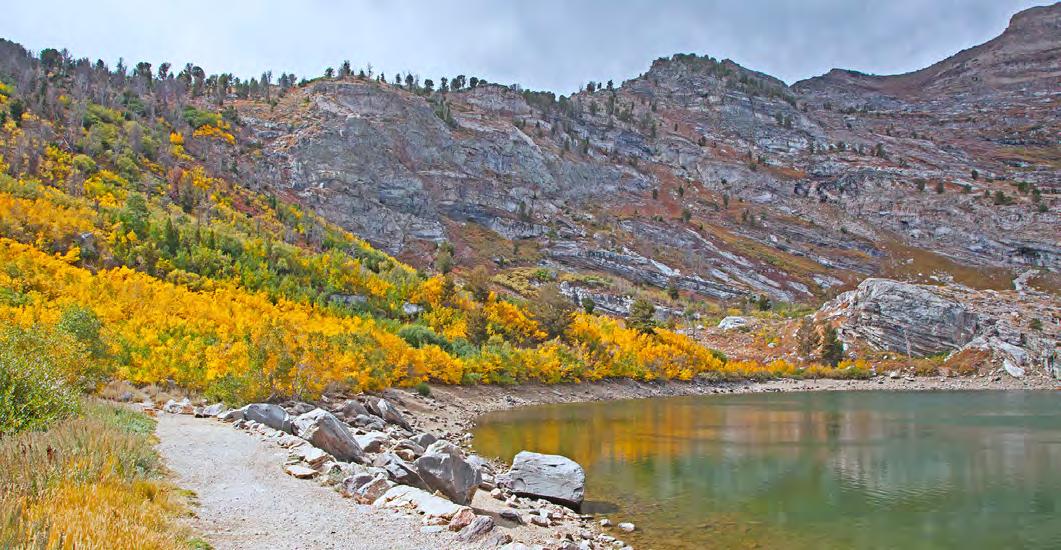
The range was named for visionary German scientist and naturalist Alexander Von Humboldt; his name adorns peaks, counties, rivers, currents, parks, plants, animals, and forests from Tibet to New Zealand to Greenland; there’s even a lunar feature and an asteroid named for him. The



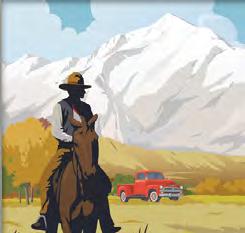
While California and Utah adventurers compete for permits and get hassled by law enforcement, an intrepid Nevada explorer is almost guaranteed solitude and freedom. On the other hand, nobody’s coming to rescue you and there’s little cell service, so plan accordingly.
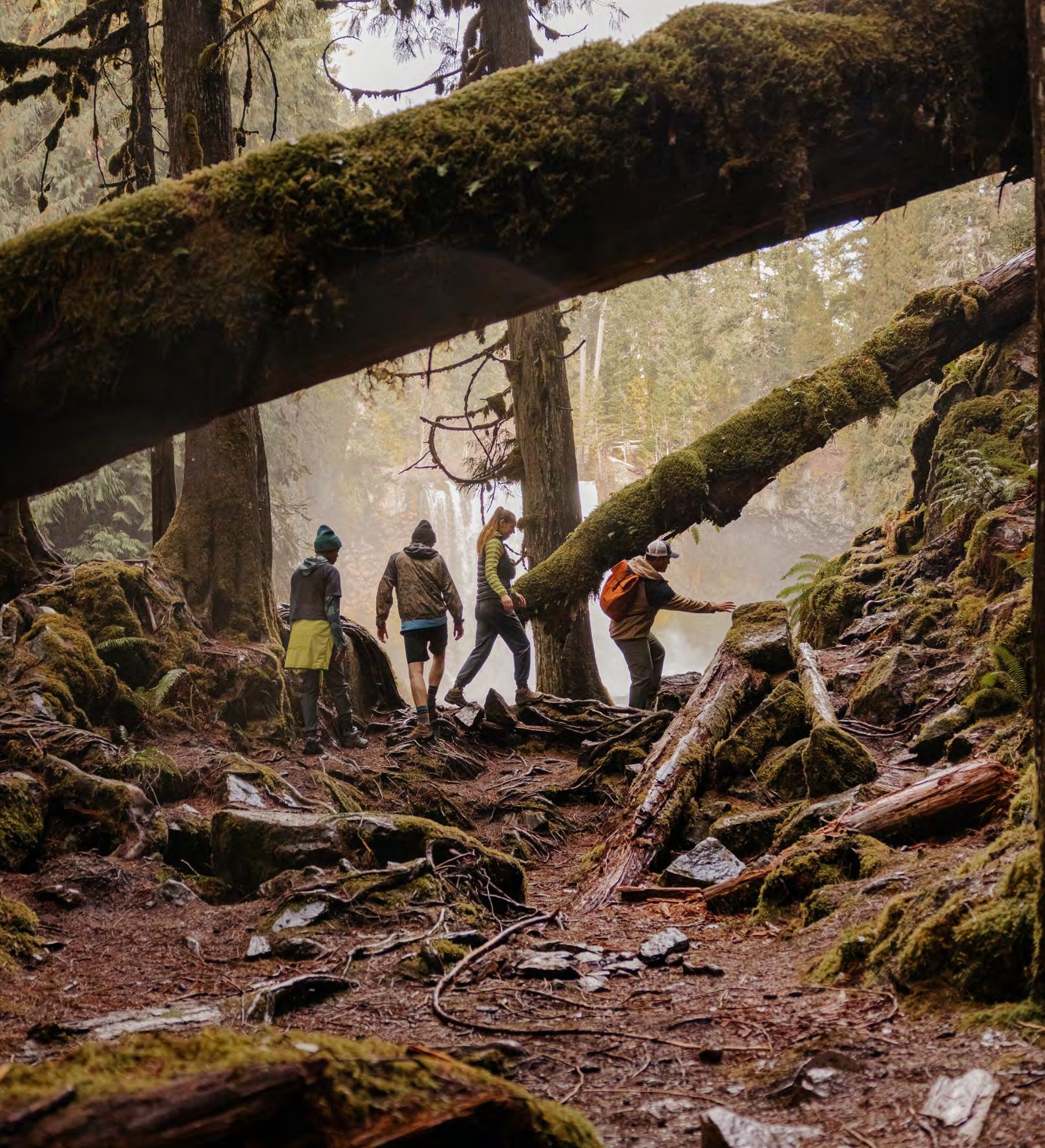

centennial of his birth was celebrated by hundreds of thousands worldwide. One hundred fifty years later, nobody remembers who he was, but his ideas, maps and writing continue to shape the modern fields of ecology, biology and plant biogeography.
Humboldt set out to discover how “all forces of nature are interlaced and interwoven.” He came up with the idea of vegetation and climate zones that circle the globe and invented isotherms, the pressure, and temperature lines on modern weather maps. A hundred years before the term “global warming” was coined, he was talking about the damage of human-caused climate change and deforestation. Learning about naturalist heroes of the past can inspire us to preserve our favorite wild places for the future.

The arid, barren Toiyabe Range in central Nevada features a 65-mile long recreation trail that hugs the crest; for 50 miles it stays above 10,000 feet. This wall of mountains rises 4,000 feet from neighboring valleys, and runs north-south for 120 miles, making it the second longest in the state. Lack of vegetation means the area is ideal for cross country travel; the presence of cows and lack of water pose a challenge. Rutted dirt access roads guarantee little visitation.
Toiyabe is an ancient Shoshone word


for mountain. The Western Shoshone, native to the Great Basin, currently live in Nevada, Utah, Idaho, and California. Historically the tribe comprised about ten bands, named for their homeland and primary food sources.
In 1863, some members of the Western Shoshone Nation entered into the Ruby Valley Treaty with the US, which delineated the boundaries of a 40,000 square mile territory over which they were promised sovereignty. They never consented to have this territory included in any state. They mounted legal battles that halted the proposed nuclear waste dump at Yucca Mountain, and resulted in settlements of over $100 million meant to extinguish their claims to the land. Those payouts languish with the federal government while the Western Shoshone continue to fight for the rights they were promised with the Ruby Valley Treaty.
In 1992, the Western Shoshone began issuing their own passports. Any passport holder can access their traditional territory, but walk with respect for the area’s original inhabitants.
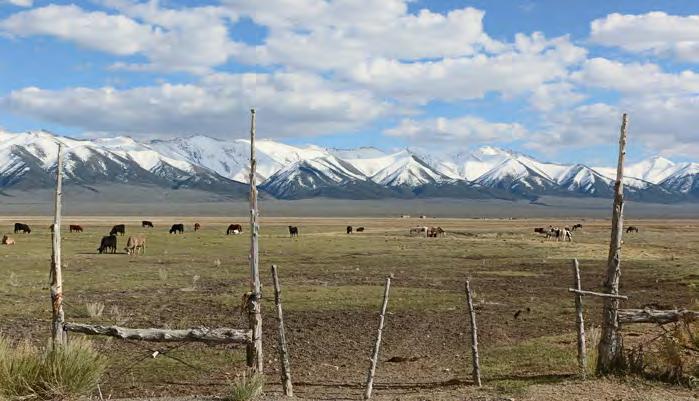
These are just three of the Silver State’s hundreds of mountain ranges. Each is worthy of exploration. And not only does Nevada have more mountains than any other state, it also has more hot springs — each of those is worthy of exploration too!



The lure of adventuring, living and working in nature is a strong one. Especially since COVID, many have hit the road in a van or camper to wander wherever their WiFi lets them. But now we’re also hearing something else: some of our seasoned road warriors are settling down; they have built a home base for shorter, deeper explorations.
That doesn’t mean they‘ve stopped adventuring, they are just seeking balance and respite. How do they do it? And why? You’ll find a mix of motivation and method in their stories, which follow.
Kayak instructors and nature guides
Home base: Fort Bragg
Rig: 2017
Toyota RAV-4
One Cali road trip: Smith River whitewater
Connectivity: Goal Zero Nomad 20 solar panel charger
Helpful resources: Sea Kayaking
Central and Northern California by Roger Schumann and Jan Shriner, and The New School Guide to Northern California Whitewater by Dan Menten Online: liquidfusionkayak.com
From late May to September, Cate and Jeff are home, teaching and running trips full-time out of their shop, Liquid Fusion Kayaking, on the Mendocino Coast. Then, they’re off to a West Coast destination, still teaching but also exploring. Jeff sometimes teaches alone, but for their adventures Cate is always with him.

The couple makes the most of their
driving time. “Podcasts,” Jeff says, “let us learn while driving.” Their current favorite is “Awkward Watersport Guys,” hosted by industry experts Greg Fisher and Kevin O’Neil.
The couple also has a small “natural history” library that includes a California Atlas and books on California plants, animals, birds, geology and history. But, Jeff notes, it’s been shrinking over the years as they rely more on their phones. Of course, having access to power is key in all of that and Cate, the “master of electrics,” keeps cameras and other gear ready to roll.
Jeff says how the two travel has changed over time. These days they try to avoid air travel and its ecological consequences. Instead, they look for places closer to home – like the Smith River – and try to make the most of the immediate venue, setting up short shuttles or even a “park and play. “
“You don’t have to go super far to have amazing experiences,” Jeff says. “The kayak is just the nature delivery device.”
Construction and veterinary technician

Home base: Reno/Tahoe
Rig: 2013 Ford F350 pulling a 2015 Dutchman V3650
Voltage and a 2019 Ford Transit Van Connectivity: RV resort WiFi boosted with King WiFiMax, or Verizon Jetpack MiFi 8800L
One Cali road trip: US Route 395 from Tahoe to San Diego
Helpful resources: iOverlander app (for finding places to stay); FarOutRide.com and Fulltimefamilies.com
Eric was Northstar California Resort’s race director for 13 years, working all year on events including the Northstar Enduro, part of the California Enduro Series line-up. In 2020 he and his wife Deena sold their home in Truckee. Since then they have been traveling around the country, piecing together work and riding bikes recreationally with their two daughters and three dogs.
Life on the road has forced the family to live a more simplistic life and be more flexible. The trade off is that they can
plan day-to-day around the weather and their desires and interests. On days they aren’t driving, they are doing school and work in the morning, enjoying the outdoors in the afternoon, and dinner and a movie or game at night.
You’re “not on vacation,” says Eric. “So you don’t have to cram everything into a short time. You make it happen when it fits.” And that, as others have said, requires continuing communication with spouse, kids, and, possibly, dogs.
The family has stored most of their possessions at a friend’s home in Reno. But managing everything they have with them “is a constant shuffle.” When they find a packing solution, they take a picture of it, so they can recreate it again after they unload. They also say a must is having weatherproof storage bins that can go outside — which is where the dogs’ beds go too.
Their girls, Avery and Mikaela, who are homeschooled, recently asked if they might move back into a house for a bit. So Eric says the family may soon be taking a break from the road.
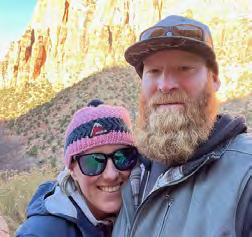
In the meantime, “We call Reno/Tahoe our home base,” says Eric, “but we consider our actual home to be where our RV is parked at that moment in time.”
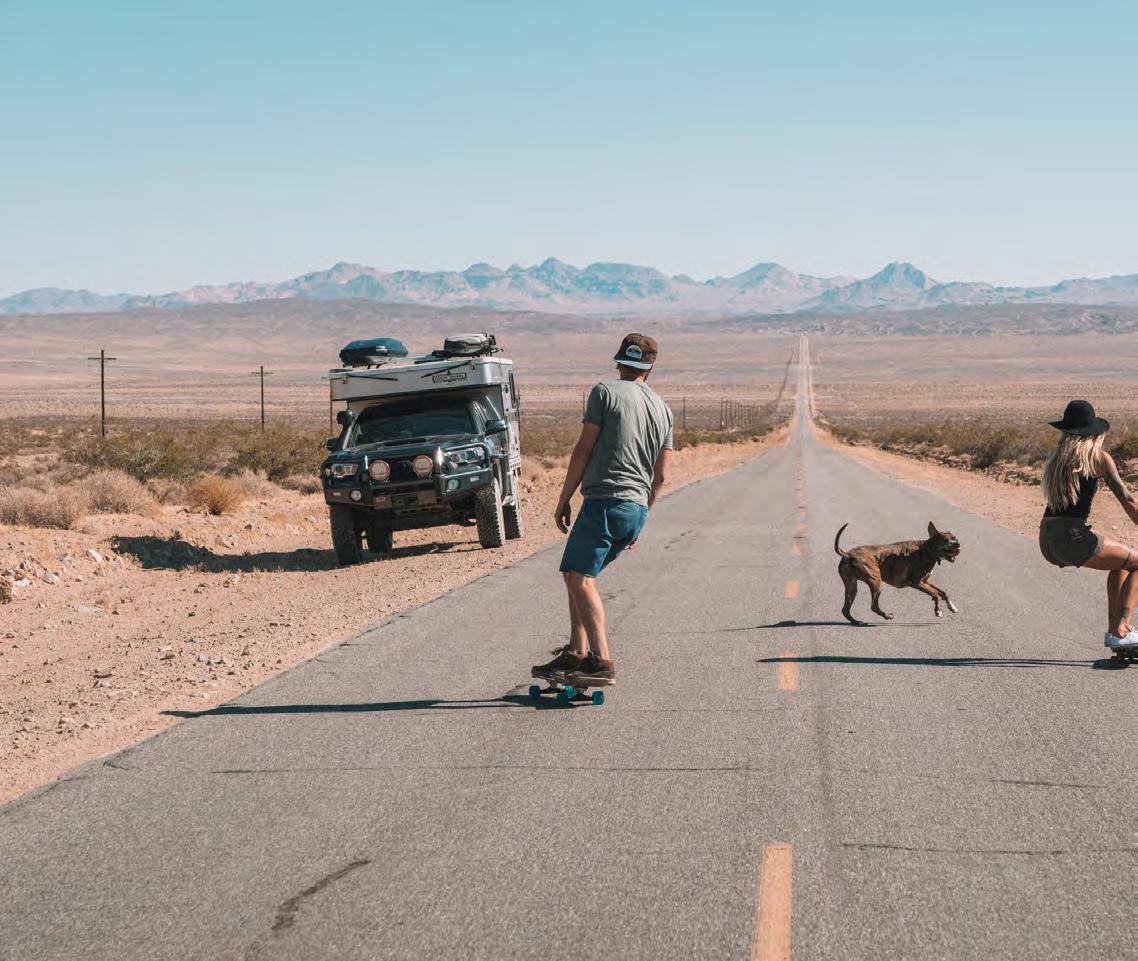
Cyber threat intellence specialist and electrician
Home base: Colorado Rockies
Rig : 2018
Tundra with 2019 Hawk
flatbed by Four Wheel Pop-Up Campers
Connectivity: Satellite internet via providers, Viasat and StarLink , also signal extenders ALFA Network WiFi CampPro 3 and Winegard Connect 2.0 WiFi & 4G LTE
One Cali road trip: Surfing the California coast from Humboldt County south
Helpful resource: Bend to Baja by Jeff Johnson
Online: Instagram: @surf.climb.travel
Jessica works forty hours a week as a Director of Intelligence Analysis for Dragos, leading a team of people who hunt hackers in systems that control water, food, transportation, and power. Jessica is passionate about demonstrating that, yes, you can work full-time from the road and still have a life tied to adventure and nature.
“Yes, Charles and I actually work even if you don’t see us sitting in front of a computer on our Instagram,” she
says. “This lifestyle is very attainable for people who have to work.”
Not that it doesn’t require some planning. Jessica decides where she’ll set up and the technology needed the night before her video calls/meetings. Wi-Fi boosters, repeaters, and satellite Internet are all in the mix and there’s no one solution.
“It helps to create a specific space for working,” she adds. “You have to set boundaries both ways. If I’m working in the camper, this is my spot. If I’m working outside I have an umbrella set up to shade my screen.”
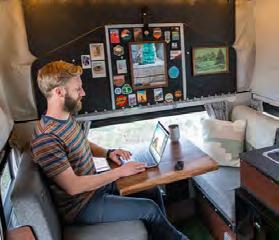
They wanted a predictable space for when Charles’ 13-year-old daughter comes for visits, so they bought a place near the Rocky Mountain National Park It’s up a three-mile dirt road, with a well and septic system.
The couple has 24 chickens, a beehive, and two horses that Jessica competes with in her new passion, equine endurance racing.
“I’ve noticed with people living in campers for a long time, they don’t want to give up traveling,” she says. “But they want a home base so they find a plot to create their own space and then travel from there.”
Home base: San Clemente
Rig: 2017 Ford Transit
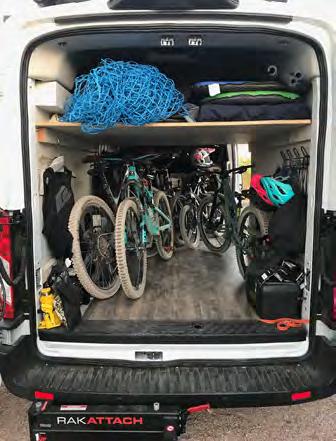
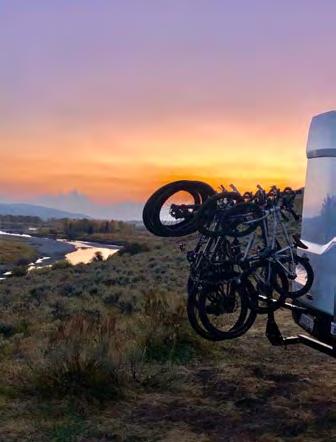
One Cali road trip: YosemiteMammoth-Downieville-Tahoe
Connectivity: weBoost cell signal booster
Helpful resource: Trailforks app (for new places to ride or run)
Online: Facebook.com/Millercoaching
Acollege soccer player, Jeana later competed in triathlons and bike races including the Tahoe 100k. She’s still traveling as an expert coach for mountain bikers, trail runners, and other endurance athletes.
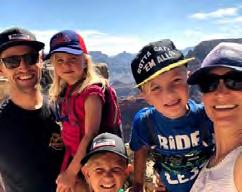
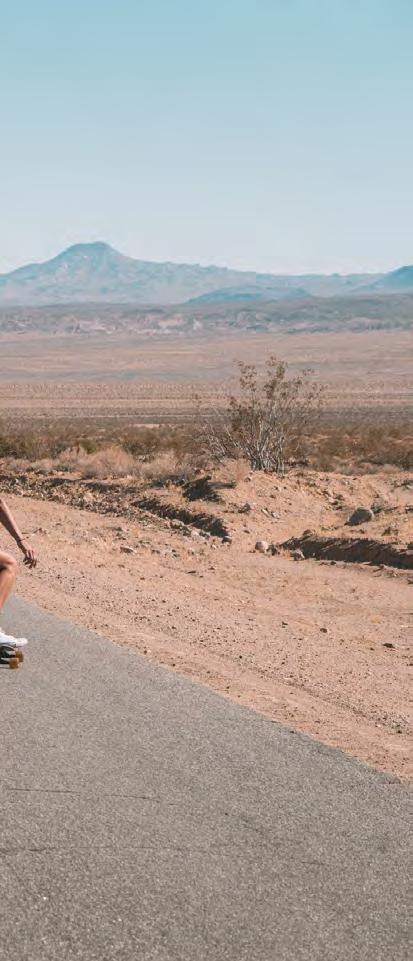
Jeana is also the mother of three children, aged 10, 8, and 5. They attend traditional school but take independent study while on the road.
Training herself while training others means sticking to a tight schedule. She does her own cardio or strength training and then reaches out to clients about their daily routine.
It helps that both she and her husband
work remotely. “We take turns working out and watching kids. We also schedule calls around each other so someone is with the kids while the other is working. Communication is critical if you’re going to juggle van and worklife,” she says.
Connectivity is critical too when on the road. The couple check cell service maps and use different cell phone providers. That way they can run a hotspot on the phone that has the most bars. “We also look at our scheduled calls and take them closer to towns/areas with good service then go adventure further down the road after work if an area has poor service.”
Adventure photographer
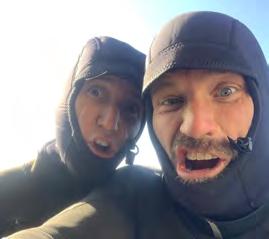
Home base: San Diego
Rig: Toyota Tacoma with Four Wheel Camper Fleet Model

Connectivity: WeBoost
Antenna, Verizon MiFi Jet Pack
One Cali road trip: Up 395 across through Yosemite to Big Sur Online: travisburkephotography.com
Instagram: @travisburkephotography
Travis Burke is one of the originals. Over a decade ago, he hit the road as part of his job as an in-house photographer to follow surfers, climbers, paragliders, skateboarders, and slackliners around the world with his camera. “I got intrigued by the remoteness and the risk of this type of work,” he recalls.
His own skills as an adventurer and athlete were a plus. “The athletes trusted me because I could go to some of the same places they could,” says the 35-year-old, who has worked with some of the best. These days, he’s more interested in capturing landscapes and remote destinations.
Burke’s had a few vehicles along the way, and now he’s got a rig with a Four Wheel Camper. Though it includes many conveniences, he still heads to a local library when he feels like he needs to spread out a bit.
Burke’s work has brought him and his Internet followers to places around the globe. Early in the pandemic travel restrictions left him stranded in New Zealand for four months. He and his partner Laysea Hughes spent some of that time exploring in a campervan, the rest of it living in yurts and cabins in natural settings.
They liked it, and when they returned home they decided to build a tiny home near San Diego using reclaimed wood and eco-friendly materials. Of course, they’re still moving around and trying new things. Early summer they drove through some of the western states. One stop was Jackson Hole where Travis did some river surfing on the Snake’s Lunch Counter wave.


Heading south from Monterey your first surf break will be Andrew Molera State Park. It sits along the coast where the Big Sur River meets the great Pacific Ocean. Park along the highway or pay the day use fee and take the Beach Trail for the most direct access to the break. Conditions are best with winds from the northeast in the fall with a moderate
to larger west and/or south swell on low and medium tides. There can be a great right hander at the river mouth and a fun point break. You can reserve a camp spot at the park up to six months in advance (reservecalifornia.gov). Alternatively, try Big Sur Campground (bigsurcamp.com) or head back to the Big Sur River Inn (bigsurriverinn.com) for a great meal and a nice bed.
The packable, portable, and always adventure-ready ENO SingleNest Hammock is your all-access pass to explore, connect, and relax.

Whether you are a born and raised Californian, or just a visitor to the Golden State; Big Sur is a must for any surfer. Jaw-dropping vistas, empty lineups, and a true detachment from the urban crowds; here are three spots to hit for the perfect Big Sur road trip.
Continuing down the coast, the next best spot for surf is the iconic Sand Dollar Beach. This beach is often the most consistent beach for surf and its aptly named sand dollar-shaped bay catches swell from all directions. There is a large lot for day parking, with a fee of $5, and it’s equipped with restrooms. Take the stairs down to the beach. The south end of the beach usually offers up the best shape, as well as an easier paddle out on bigger days. Camping is available right across the street at Plaskett Creek Campground, or down the beach at my favorite Kirk Creek Campground; either can be reserved online at recreation.gov.
Just a few miles south of Sand Dollar Beach is the elusive Willow Creek break. Take the road leading to the Willow Creek picnic ground, which is a narrow road with parking for about ten cars. Conditions here can be hazardous with exposed boulders and lots of hefty bull kelp in the line-up. But if you hit it right, with a moderate to big west swell, medium tide, and wind out of the northeast, Willow Creek can offer a juicy long left-handed point break that can usually hold up to double overhead waves. This break has more power and is best for experienced surfers that crave a meatier wave. You can get lucky and reserve a camp spot at Plaskett or Kirk Creek campgrounds or splurge for a memorable ocean front room at the Lucia Lodge (lucialodge.com).
If you are wanting to beat the crowds and don’t mind cold water and stunning views, Big Sur is for you. Always be mindful of the risks; rip currents, rocks, water quality and sharks are all a factor in surfing. Use good judgement, surf with a friend, and always leave no trace. Hope you get some good ones!
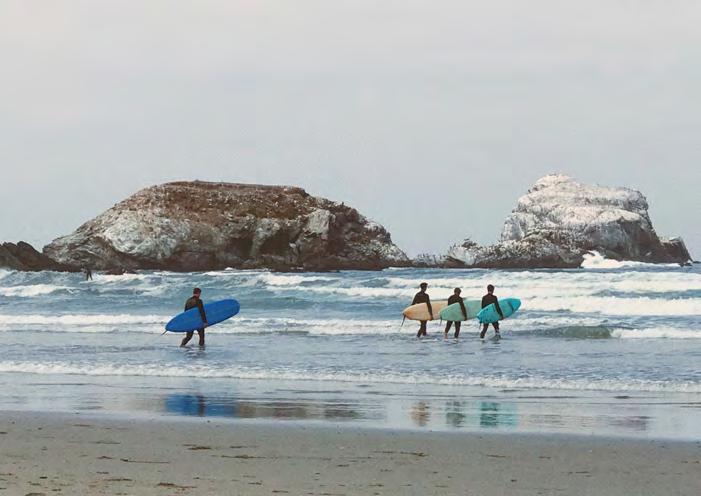

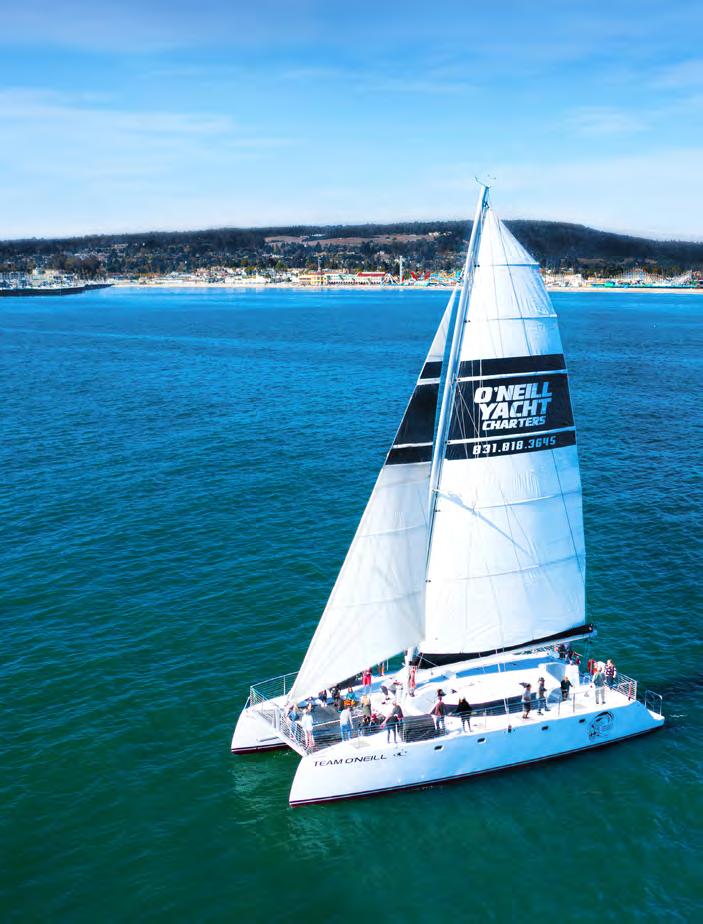



RED TIDES In Monterey Bay, red tides are most common in the warm, calm waters in the fall. A red tide is a naturally occurring, higher than normal concentration of phytoplankton. Pigments in the phytoplankton can cause the water to turn red, brown, or orange. Most red tides don’t pose an immediate threat to humans but can cause skin irritations and burning of the eyes. Certain red tides can create toxins that are harmful to marine life, so be careful to avoid eating shellfish during a red tide. Also, your dog can become ill if they are exposed to the water and ingest it. If you notice the water has a murky, red tone to it, or any type of foul smell, best to take a beach walk rather than a surf. For more info go to: sanctuarysimon. org and click on Monterey Bay.
SHARKS Yes, Jaws does live and breed within the Monterey Bay and the surrounding California coastline, and recently juvenile great white sharks have been found in alarming numbers. Scientists say this is due to climate change. Unlike adults, juvenile white sharks do not have the ability to retain heat and therefore stay in warm waters closer to shore. Scientists explain that a heat wave, which they named a “blob” of warm water which lasted for several years, caused a warming of ocean surface water that created a swim corridor from Santa Barbara (which used to be the juvenile northern range) all the way to Aptos beaches in Santa Cruz. Young juvenile sharks generally don’t pose a threat to humans as they’re still feeding on smaller prey, however as they get older and transition in to adults they are more likely to make mistakes while hunting for larger marine animals. Most bites are investigatory or mistakes in food prey. Shark attacks on humans are extremely rare, with only ten recorded in Monterey Bay since 2003. To learn more visit: ksbw.com and search juvenile white sharks.
Use good judgement, surf with a friend, and always leave no trace.
For all you conscious travelers out there looking for a different way to adventure, meet Soul Community Planet (SCP) Hotels. As a brand founded on the core values of wellness, kindness, and sustainability, the focus is on local, hand-crafted, and environmentally-friendly details that make for a cozy stay.
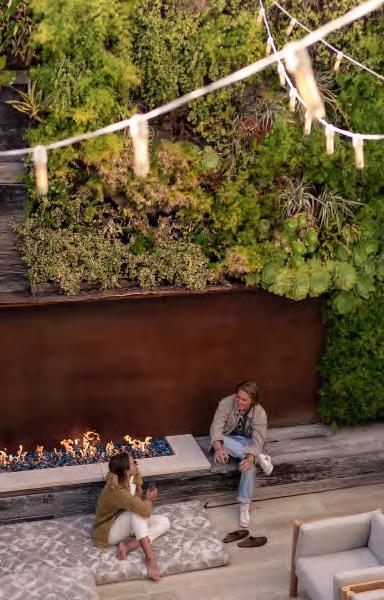
SCP’s holistic approach toward health and hospitality, combined with the power of social good, means you can rest easy knowing you’re taking care of yourself and the planet when you stay at one of their hotels. By simply booking a room, you provide mental health resources to adolescents through WE Well-being, light the home of a family in need through Miracles for Kids, and plant a tree in an unnaturally deforested area through One
Tree Planted.
Whether you’re looking for a relaxing getaway or non-stop fun, a romantic trip for two or a family vacation, just wait until you see what SCP Seven4One has in store for you.
Experience the best of what Southern California has to offer while staying in comfort at SCP Seven4One. Located a block from the dazzling blue waters of the Pacific Ocean and minutes from all of downtown Laguna Beach’s art, dining, and adventure, this is the perfect location for a relaxing getaway.


Each of the twelve rooms in this intimate boutique hotel—including two spacious suites offering stunning views of the ocean—was designed to ensure a restful
stay with minimalist features, walk-in showers, planet-friendly bath products, and unique amenities like circadian lights and essential oil diffusers. During your stay, you can even borrow a book from the library on the first floor to read by the gas fire pit in the garden or on the rooftop lounge.
Once you’ve gotten settled into your room, it’s time to get out and tour the beauty of Southern California’s coast. As you walk the blocks surrounding the hotel in search of restaurants, art galleries, and entertainment, keep an eye out for more than 100 pieces of public art around the city inspired by Laguna Beach’s coastline, wildlife, and cultural heritage, including a variety of murals, statues, sculptures, and signs.
Adventurous souls will find there’s even

more to do at the area’s various parks and beaches. SCP Seven4One is steps from iconic surf spot Thalia Beach, so grab your board and get out on the water.
Within a ten-minute drive, you can be surfing the salty waves at Aliso Beach Park, exploring the tidepools teeming with wildlife at Main Beach Park, and walking the trails through the canyons and rocky bluffs of Laguna Coast Wilderness Park. Who knows what new sights and experiences you’ll stumble upon?
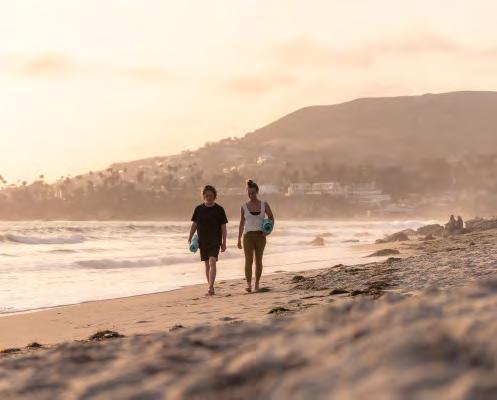
After a day of adventure and sightseeing, there’s no better feeling than having a cozy bed awaiting your return. This is your chance to recharge your body, mind, and soul all while knowing that Every Stay Does Good at SCP Hotels. Plan your visit at SCPHotel.com as you reconnect to nature and yourself in Laguna Beach.

A holistic approach toward health and hospitality, combined with the power of social good, means you can rest easy...



JUNE 25, MARIPOSA, CALIFORNIA It’s just past 1pm, and it’s sweltering here in downtown Mariposa where I’m attending Mike Corbett’s celebration of life at the Yosemite Climbing Association Museum. We’re here to remember “Mr. El Cap,” a sports legend who scaled the monolith’s face 56 times. The man who brought Mark Wellman to both the summits of El Cap and Half Dome, making him the first paraplegic to do so. It’s an event that culminated in an invitation to the White House. In Mariposa, the audience is a who’s who of climbing, including free soloist Peter Croft, and big wall first ascensionist (and Corbett’s best friend) Steve Bosque.
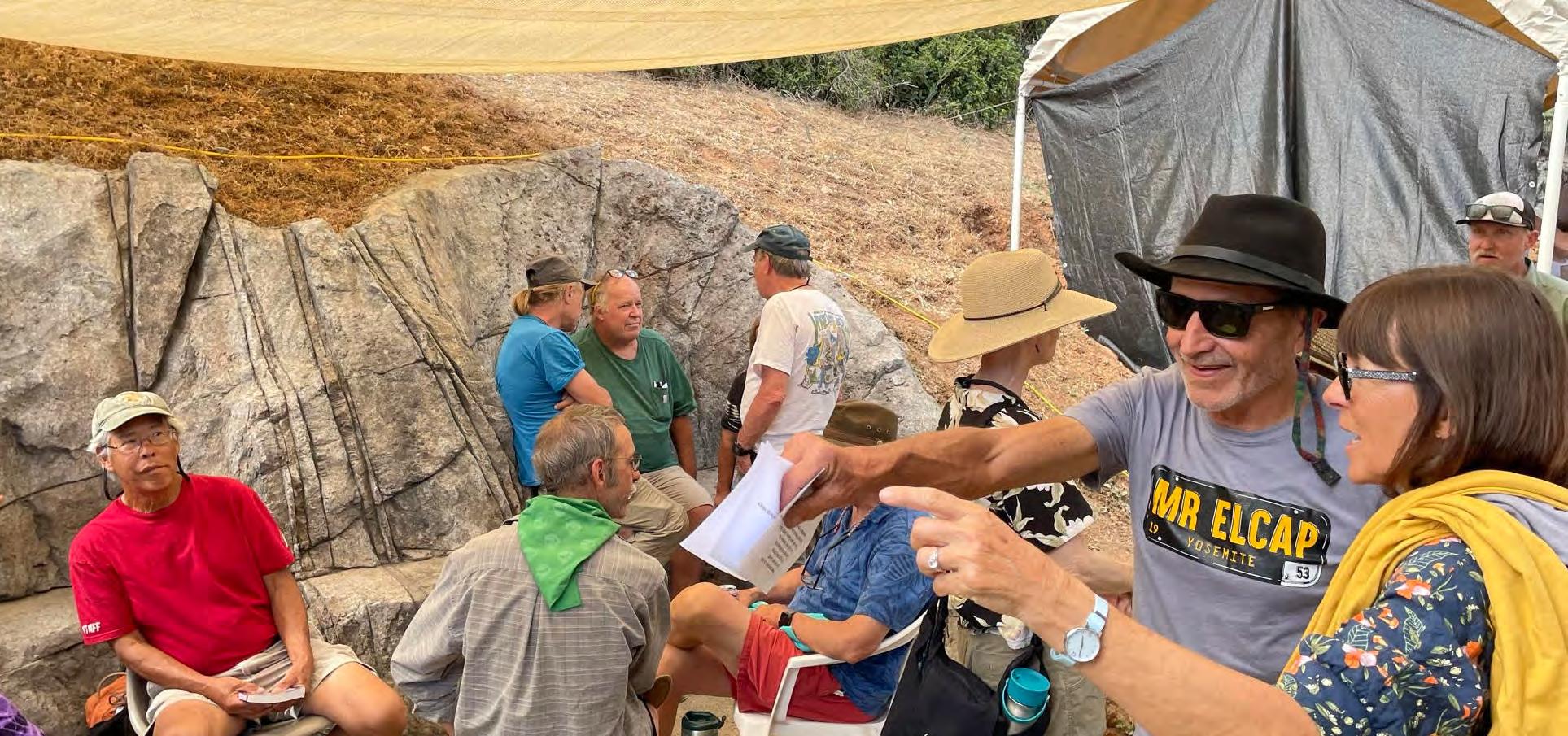
Shortly into the memorial, someone faints from the heat and an ambulance is called. Once the patient recovers, the program restarts. The audience talks amongst one another; some haven’t seen each other for ages. It’s a reunion, though we’d all prefer to be meeting under different circumstances. Corbett was a dear friend to us for many years.
I’m here as part of the Curry kids’ scene, the tight group of late teens/early twenty-somethings who met in Curry Village in Yosemite Valley in the mid90s. That’s when we met Mike Corbett and Ken Yager, co-founders of YCA. Back then, I often visited their museum displays. When YCA began holding park clean-up events called Facelift, I covered it in its third year for my first print story in Climbing Magazine. That was seventeen years ago. (Over the years, the annual event has resulted in the removal of over one million pounds of trash from the Park.)
Corbett and Yager started YCA together, with the climbing museum and trash cleanup events as the primary focus. Then, over the years differences pushed them apart. More recently they healed this

rift and began working together again. Speaking to the audience in Mariposa, Yager talked about how happy he was that Corbett, his big wall partner since his earliest years in the Park, reconnected for the last year of his life when the two of them worked side by side at the museum. Yager talked about them making the fourth ascents of Zodiac and Tangerine Trip, then considered some of the most challenging and dangerous walls on El Cap. The decades passed, and Corbett settled in nearby Ahwahnee with his wife. Yager eventually settled in Mariposa and opened the climbing museums in his hometown and Yosemite Valley.
“I’m like a dog biting onto a pant leg,” Yager said to a packed audience at Corbett’s memorial, describing his relationship with the climbing museum and Facelift.

For two decades, Yager relied on volunteer help, but now, as he’s nearing the 20th year, he’s making massive improvements, including hiring staff, raising money, and going national.
As I saw first-hand with the memorial and the afterparty held at the nearby Yosemite Boulder Farm, everything was very well organized. There a row of caterers served barbecue tri-tip and chicken near the dance floor as a band played. I walked up to Yager and said I was impressed. He replied, “This is what I do. I put on another event last week.”
Over the decades, Yager built the annual Facelift into the largest Yosemite gathering of the year, volunteering hundreds of hours to do something that gives back to the Park while making it fun. The film Free Solo premiered during one Facelift to a packed audience that went wild. After successful shows year after year in Yosemite, Yager is now taking it nationwide with Facelift Act Local.
“We’re getting big, that’s for sure,” says Director Timmy O’Neill about what is happening now with the Yosemite Climbing Association (YCA) locally and nationwide.This page, top to bottom: Ken Yager and friends gather at the Yosemite Boulder Farm near Mariposa to celebrate the life of Mike “Mr. El Cap” Corbett (Elizabeth Tucker); Yager stands outside the YCA headquarters and climbing museum in Mariposa (Chris Van Leuven); Early pitons and caribiners on display at the YCA climbing museum. Opposite page, left to right: Yager addresses a large crowd of Facelift volunteers during the annual clean up event (YCA); Yager at the YCA museum with photos of Royal Robbins and Warren Harding in the background (Chris Van Leuven).
Starting during Covid, when it was impossible to host an event in the Park, Yager and his board of directors began doing virtual clean-ups, where people could get involved via social media by tagging #faceliftactlocal with their images. That first year during Covid, 1,200 people were involved. With the success of Act Local, Yager is now expanding, hoping to make clean-ups in various locations as consistent as his efforts in Yosemite. Though Yager is the president of YCA, he also takes input from general counsel Kristine Mostofizadeh and board members Beth Rodden and Emily Harrington. Mostofizadeh brings 20 years of legal experience to the non-profit. Rodden, one of the world’s top rock climbers, who has climbed in the Park since the
“I’m like a dog biting onto a pant leg,” Yager said to a packed audience at Corbett’s memorial, describing his relationship with the climbing museum and Facelift.

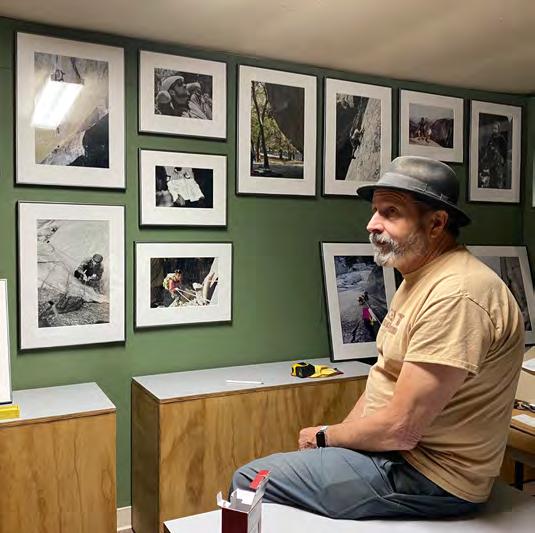

90s, has freed the Nose. She resides in Yosemite West. Harrington is one of the most diverse rock climbers on the planet. She’s a five-time US National Champion, a 5.14 rock climber, Everest summiteer, and accomplished skier who descended the world’s sixth-highest peak. She’s also the fourth woman to free El Cap in a day.
Other YCA staff members include Events and Partnerships Manager Karin Tarpinian, Event Coordinator Linda Jarit, Museum Manager Hannah
Fleetwood, and Directors Tommy Caldwell, Timmy O’Neill, Sandy Russell, Don Mealing, and Jack Wurster. Plus volunteers Les Chou and Hugh Sakols greet guests.
Some weeks ago, I attended my first board meeting with YCA outside their headquarters in Mariposa. I arrived by e-bike and pulled up to the picnic tables outside the museum, where the crew discussed doing five main events a year and hosting virtual events around Facelift. They said that getting this
We

Adventure Sports Journal is one of the last independent outdoor magazines in the country. We are in direct competition with corporate media and online platforms. ASJ depends on the support of our advertisers and people like you.


We think ASJ is an important voice for the outdoor community in California.

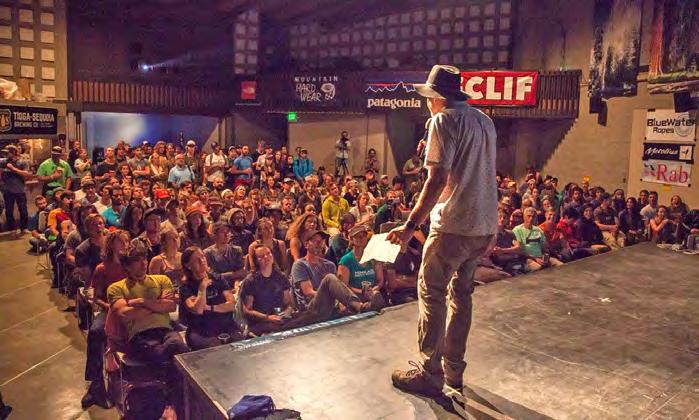
If you agree then consider helping us continue our work by becoming a member.
Memberships as low as $5 per month and includes a subscription!

adventuresportsjournal.com/membership



and all the other balls already in motion would be challenging, especially with their next Yosemite Facelift coming up in five months.
“This is where we aim to launch it nationally at the state or national parks,” O’Neill says. “We can identify groups already doing it and help them help us. We brand it as Facelift, and then we work with underwriters.”
One day the team would like to see monthly Facelift events. Their first locations will include Rocky Mountain National Park, Mammoth Lakes, Salt Lake City and Joshua Tree. Then Lake Tahoe, the New River Gorge and Red River Gorge and the Shawangunks. Here volunteers will be “using trash pick-up to build community and make a habit with it,” continues O’Neill. There’ll be raffles and other incentives for participation.

“This is the beginning of the Yosemite Facelift going nationwide to Act Local Facelift,” says Tarpinian.
In addition to bringing Facelift nationwide, Yager plans to make the museum the center of the climbing scene in Mariposa. For months he’s overseen the construction of a concrete art scene by Chris Miller and Wes Segler. They created art in the backyard by installing meticulously painted concrete with black specks that blend into orange streaks that look like natural granite to the untrained eye. It
resembles Yosemite’s grand walls and shows Half Dome and Yosemite Falls, complete with an actual waterfall. Yager envisions climbers showing up here on their way to the Park to peruse books from the extensive library, fill water jugs from a spout, and look through the museum where they can see one of only a few Stoveleg Pitons, forged from a junkyard stove and used on the first ascent of El Cap in the 1950s.
“YCA is here to stay. We’re building for the future,” Yager says. “Climbing and access to the Park will get more challenging as time passes, so we need to build a strong organization involved in the park policy. I’ve always been about partnering with as many different groups as possible. You’re much stronger that way.”
The next addition to the YCA museum in Mariposa is an adaptive climbing exhibit. “We’re getting busier and busier each week,” says Yager, “it’s crazy. Some days, it feels like people are in there all day long, and you’re always answering questions. We used to have days when it was slow; those days are rare now.”
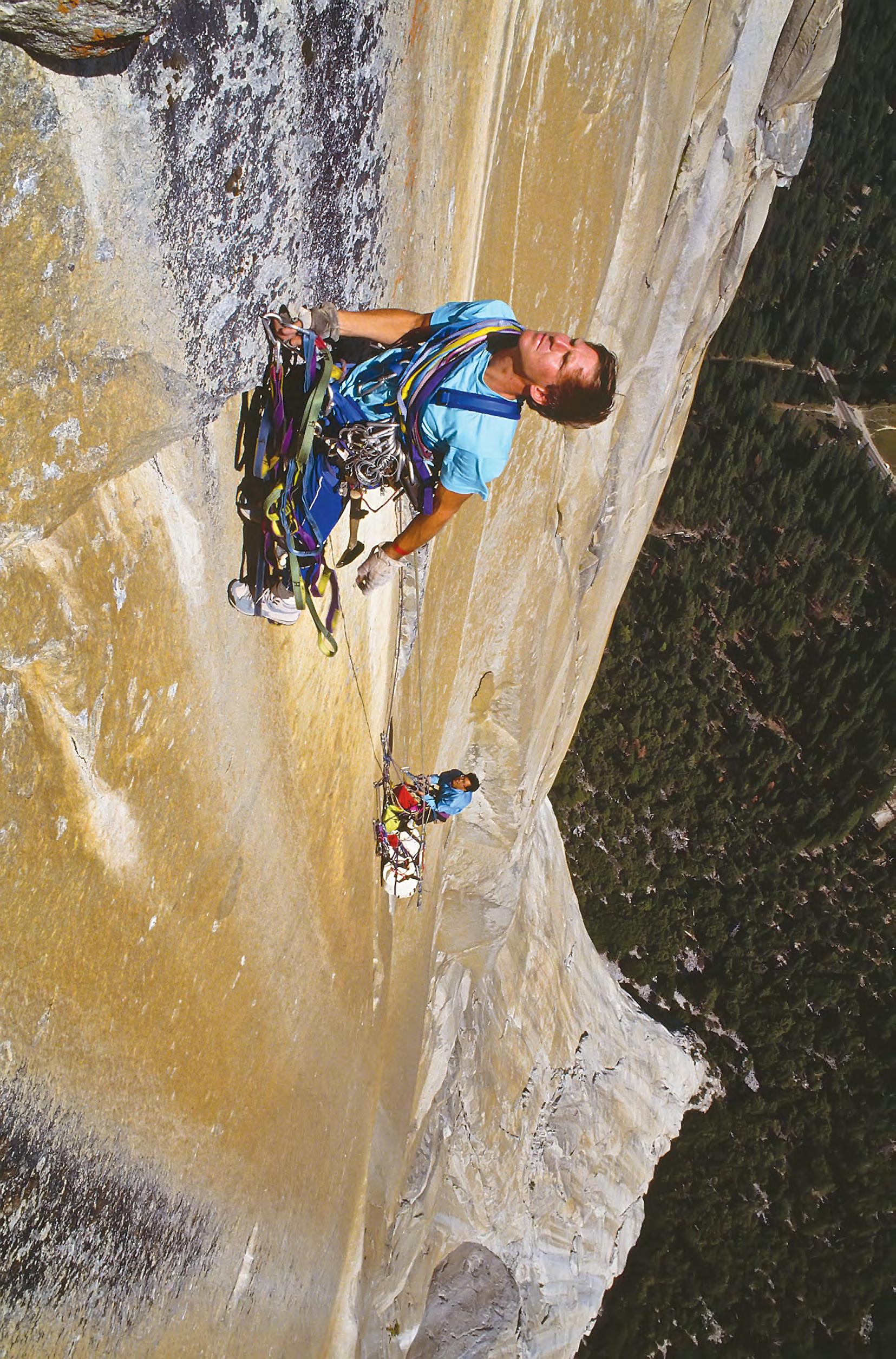
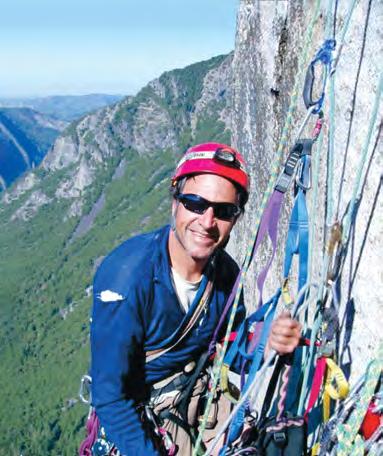



1968 changed my life in ways for which I am eternally grateful and from which I still learn. The previous year I had tuned in, turned on, and dropped out, if you are old enough to catch my meaning. I was supporting myself by teaching skiing at a resort near Lake Tahoe. During this time I made friends with some climbers, who invited me to Yosemite. I showed up a few weeks later and dove headfirst into the climbing lifestyle. While living in Camp 4 and immersed in Yosemite climbing, I met some people who changed my life.
After a month learning the basics, I left on an epic journey with Doug Tompkins, Yvon Chouinard, and Lito Tejada-Flores. We drove a van from California to Patagonia, picking up the ex-pat Brit Chris Jones in Peru. We made the third ascent of Fitz Roy in Argentina and Lito made two films, Fitz Roy and Mountain of Storms, about our adventures and interactions. It was one of the more significant climbs done in the world that year, and when I returned to Yosemite in the spring of 1969 I was a mini-celebrity despite my limited experience. It was a few years before I appreciated the true quality of my basic climbing instruction from
some of the world’s finest climbers, and a few more years before I realized how the mindfulness of their climbing had affected the path of my life. The word ‘mindfulness’ was not common at the time, but mindfulness is as old as humanity, perhaps older, and mindfulness is as central to climbing as honesty is to integrity. Without it, things fall apart. The late Zen master Thich Nhat Hanh observed: “Mindfulness practice is not an evasion or an escape. It means entering vigorously into life — with the strength generated by the energy of mindfulness. Without this freedom and concentration, there is no happiness.”
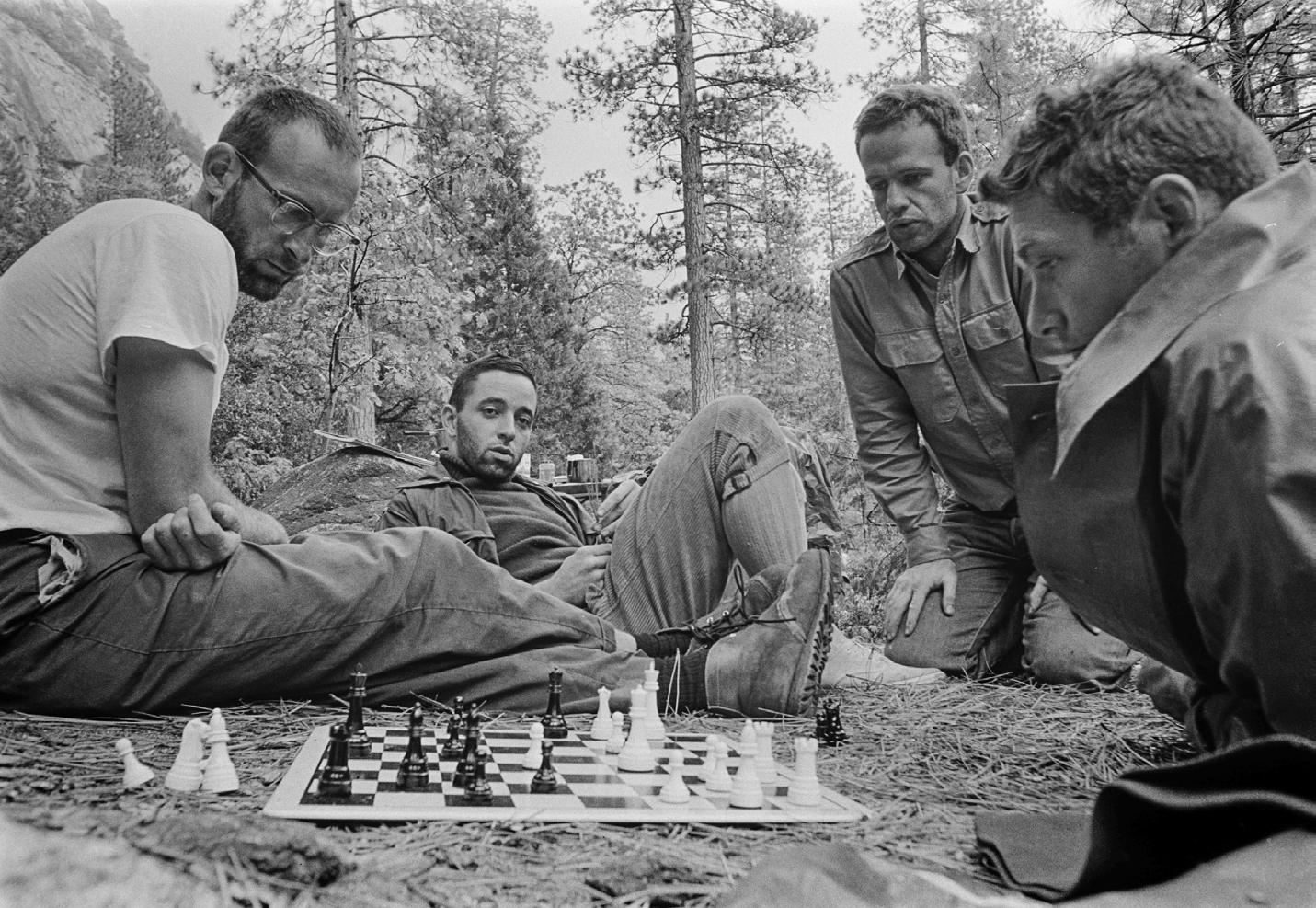
Doug Tompkins exemplified the mindfulness of joy and determination. His entire life was a celebration of climbing, skiing, kayaking, business, family, and friends. He was also doing his best to save Mother Earth from humanity’s overpopulation and destruction of Her finite environment. And Doug’s smile warmed, informed and illuminated the path of mindful living for those fortunate enough to be in his presence. After cofounding The North Face, Doug left the business world in 1989. In the 1990s he bought and conserved more than two million acres
of wilderness in Chile and Argentina. His goal was to save biodiversity on the largest scale possible. He passed away while kayaking in 2015.
Lito Tejada-Flores has expanded the limits of the possible in every activity and person he has touched. When we started the Fitz Roy trip Lito had a 16 mm Bolex motion picture camera and 200 pounds of Kodak color film. He had never operated a motion picture camera or loaded film into it, but the two award winning works from that trip (Fitz Roy and Mountain of Storms) have stood the test of time. His climbing,

skiing, kayaking, writing (including fine poetry), and cheerful, unique lifestyle have also helped expand the boundaries of the possible. Just before leaving for Fitz Roy, Lito was on the other side of the camera as a climber in Glen Denny’s film El Capitan, which documents one of the earliest ascents of the Nose route in Yosemite. Shot in 1968 and 1969, El Capitan included a lapse in Lito’s mindfulness that came close to costing him his life.
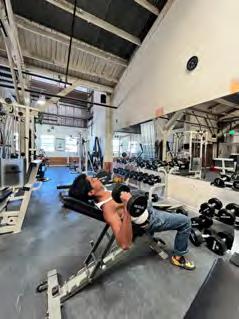
Yvon Chouinard’s childhood was shaped by the natural world of southern California. As a boy he trained falcons and learned to climb. This led him to Yosemite. The rest is history. He eventually took the mindfulness of the climbing realm into the business world. His company Patagonia is one of the most respected brands in the world. On the subject of mindfulness Yvon has written, “It was the most formative time of my life. When a 15-year-old has to trap a wild goshawk, stay up all night with her until the bird finally develops enough trust to fall asleep on his fist, and then train the proud bird using only positive reinforcement, well, the Zen master would have to ask, ‘Just who is getting trained here?’”

In 1965 Chris Jones, a recent college graduate, was living in London pursuing a traditional climb up the business ladder to financial stability and social status. He frequented Britain’s rock crags on weekends and spent three weeks each summer on the higher peaks and faces of Europe. He did not like what he saw in his future and was saved from it by following the directions of his heart. Chris quit his job, left England and moved to Truckee, California where he climbed and worked menial jobs to survive. In 1967 he moved to Yosemite and Camp 4 where he found his calling. In the next few decades he put up hard routes throughout the continent, and his book Climbing in North America is considered a classic.
There are way too many memorable climbers from the old days to make a complete list here, but in many ways we were all circling the orbits of Warren Harding, Royal Robbins and Chuck Pratt. They influenced all of us.
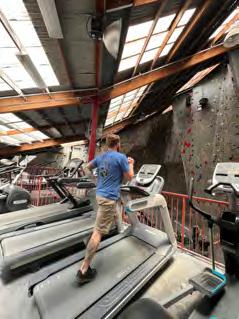

Warren Harding was the most beloved because his mindfulness was centered in his emotions. He climbed for the emotional ecstasy of the entire climb and the move at hand, and his will to persevere was as legendary as the
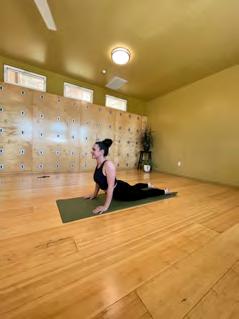
routes he pioneered and his habit of drinking way too much.
Royal Robbins’ approach to climbing was the opposite of Warren Harding’s. His mindfulness was not centered in his emotions. Still, in other ways the two men were very similar. They both had a powerful force of will that few could match. After Royal died in 2017 his daughter Tamara told Climbing Magazine, “My father faced challenges in his climbing, his writing, his business, his role as a father and husband, and later in life in his debilitating illness. Through it all, he rose to the occasion, taking the challenges on with grace and humility. For that, he’s my hero.” Tamara speaks for everyone who knew Royal, though on occasion he was also known to take on challenges with the hardness and hubris that conquers stone. Royal was not perfect but he was really, really good.
Chuck Pratt, in my opinion, exemplified mindfulness more than anyone. His attention to detail while climbing was a pleasure to watch and he took that into everything in life. His favorite activities were climbing, drinking, traveling and taking photographs of women he knew. I always wished he had spent more time writing, as his few efforts at the craft are superb; but he made it clear that he would rather climb than write about it. A remembrance I wrote after his death includes this: “By the time I arrived in Yosemite in 1968 as a novice climber, Chuck was an established master of big wall and hard technical rock climbing, regarded by cognoscenti with a respect verging on reverence. I watched him climb but did not know enough to realize what I was seeing. He free climbed like a magician, a man born to vertical stone, comfortable where others struggled.”
Mindfulness was a quality evident in every Yosemite climber I knew during the 1960s and 1970s. I see the same power of mindfulness in later generations of climbers including Lynn Hill, Alex Honnold, Jim Reynolds, Beth Rodden, Tommy Caldwell, Chantel Astorga and many others. What I see now is similar to what I first saw in 1968. The power of climbing as a practice of mindfulness.
Dick Dorworth is a climber, skier and outdoor philosopher. He is the author of Night Driving and other works of climbing fiction and nonfiction. He currently resides in Boseman, Montana.
“Mindfulness practice is not an evasion or an escape. It means entering vigorously into life — with the strength generated by the energy of mindfulness. Without this freedom and concentration, there is no happiness.”
— Thich Nhat Hanh

 By Matt Johanson
By Matt Johanson
As Minden sounded its siren at noon on May 29, a group of more than 50 Washoe and their allies shouted together in response, “Stop the siren!” Their defiant cry and a formidable eight-mile group run followed an hour-long protest of the Nevada town’s daily siren blasts. Minden has sounded a siren each evening nearly continuously since 1921, while Douglas County required Indigenous and other people of color to leave town at sundown until 1974. While town leaders claim the siren’s continued use honors the volunteer fire department and first responders, Washoe and their supporters regard it as a painful reminder of former racist practices.
“I’m here because of stories that my grandma would share with me, and all our other elders. I picture them scurrying away from town when the siren did go off. People are still alive today that would have to leave town,” said Washoe descendant Stacey Burns.
Washoe, other Indigenous people and allies from Nevada and neighboring states spoke movingly at the Minden Park gathering within view of the siren atop the fire department.
Then the group reassembled on Snowshoe Lane in nearby Genoa for a hilly run through Humboldt-Toiyabe National Forest. Leading the pack was Paiute descendant Kutoven “Ku” Stevens, Nevada’s top young distance runner and four-time high school state champion, who observed that “actions speak louder than words.”
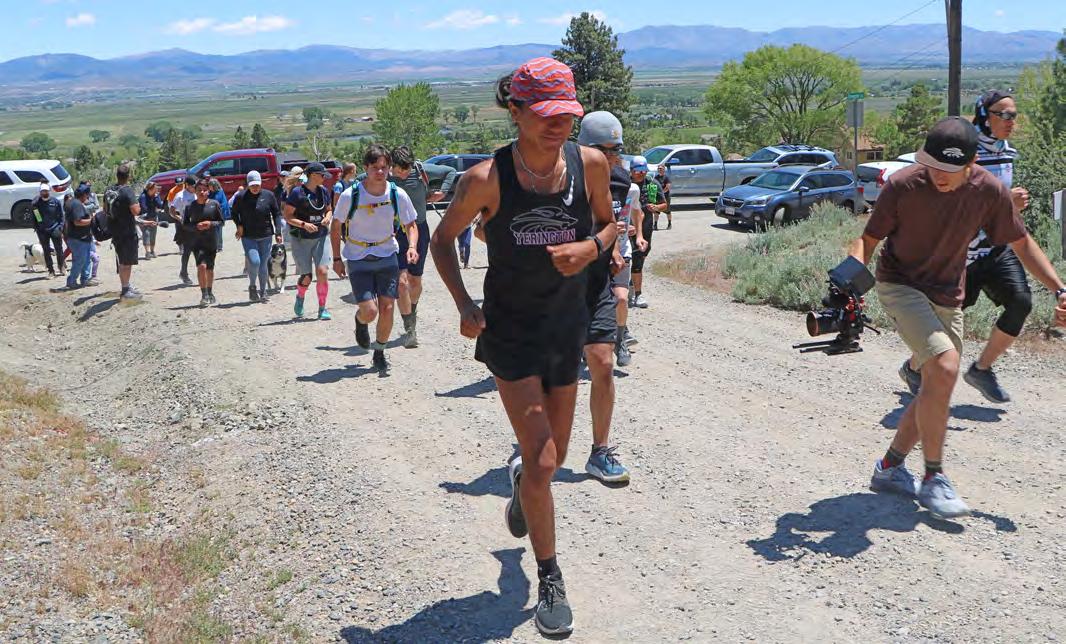

Stevens’ actions included leading about 25 runners on a challenging course which started at 5,000 feet in elevation and climbed 1,500 feet more through a forest loop. The pack varied in age from pre-teens to mid-50s, and made several stops along the way to regroup and rest. Most runners finished in two hours or more, thirsty and spent. But Stevens cruised through an easy workout, even adding extra distance at the end to keep up with his training schedule.
“It was nice having people to run with behind me, to hear their footsteps, to know that they’re here for the same reason I’m here. In a way, that was special,” Stevens said. “Hopefully people will listen to the meaning behind the run.”
Nevada banned sundown sirens in 2021, though Minden officials claim the law does not apply to their siren because
it honors first responders under the town’s 2007 retroactive ordinance. Following the state law’s passage, Minden Town Manager JD Frisby and Washoe Tribe Chairman Serrell Smokey reached an agreement to change the evening siren from 6pm to 5pm. They issued a joint statement that the change would “acknowledge the volunteer firefighters and first responders who have been historically dispatched by the town siren” and “honor those hurt by archaic sundowner mandates of prior eras.”
However, other Washoe disapproved of the agreement and Smokey’s choice to make it without consulting other tribal officials.
“I know the trauma that people live in every day in our community. The thing that keeps trauma going is the reminders of trauma that trigger us.
REACTIVE LIGHTING in our performance headlamps. HYBRID CONCEPT in most of our headlamps.
AIRFIT headband of the IKO.


FULL-TILT lamp bodies on all of our headlamps.
50:50 BURN-TIME-TO-BRIGHTNESS performance in all of our headlamps. THESE ARE THE PETZL DIFFERENCES WORTH JUSTIFYING.
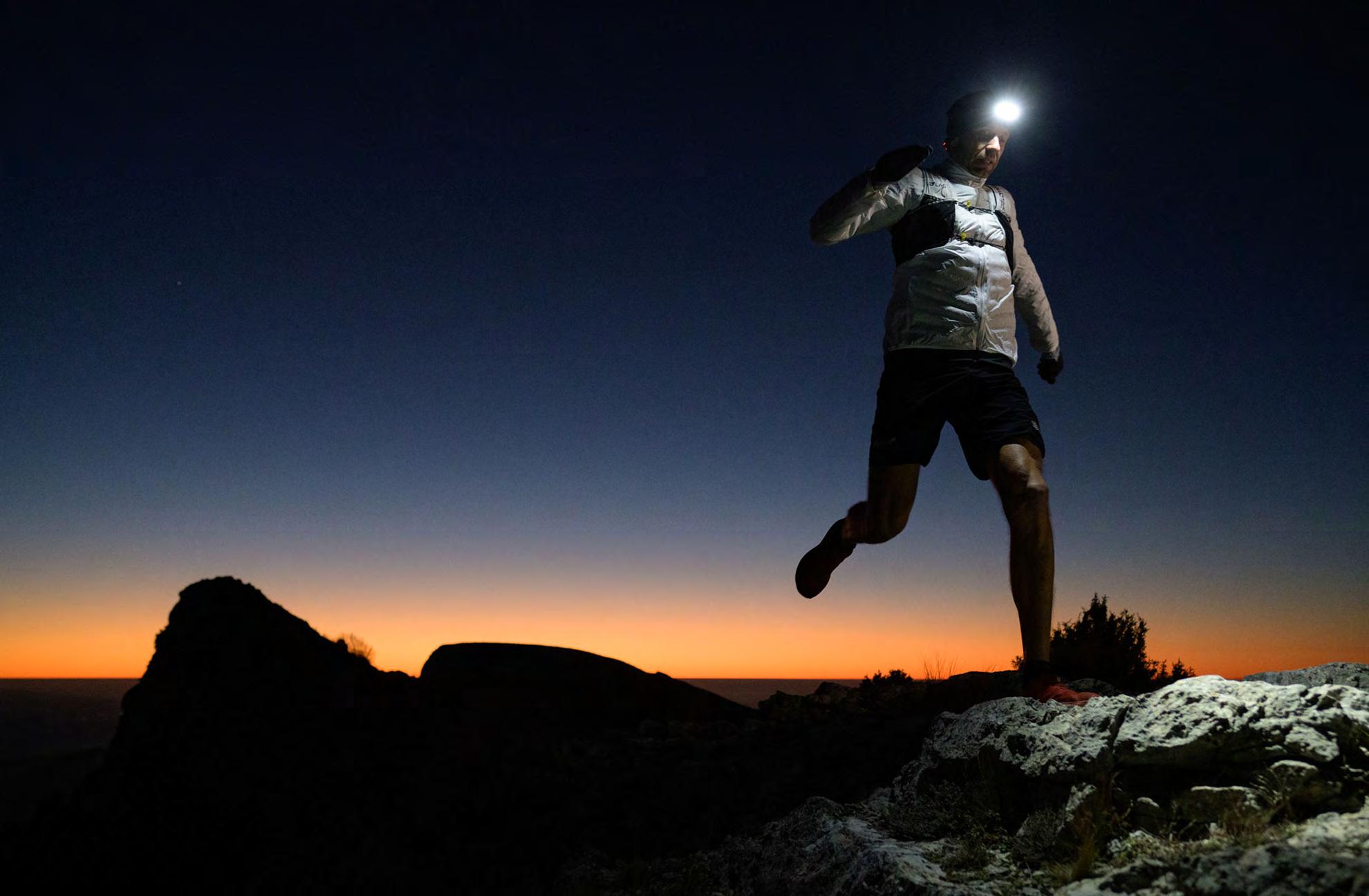
This page, clockwise from top left: Protesters shout “stop the siren,” in unison during the protest; the siren sits next to the fire department in Minden, Nevada (Matt Johanson); Sign seen during the 2022 Siren Run protest (Anthony Cupaiuolo / First Tracks Productions); Opposite page, top to right: Ku Stevens running at the front of the pack with the picturesque town of Genoa and the Carson Valley in the background (Anthony Cupaiuolo / First Tracks Productions); Delmar Stevens gives a blessing to the Lagasse family during the sage ceremony (Anthony Cupaiuolo / First Tracks Productions).

That siren every day is that trigger for our community. It’s the thing that keeps the injury going,” said Art Martinez, a Chumash.

“The Minden sundown siren belongs in a museum where the true history can be told,” said Matt Niswonger, editor of Adventure Sports Journal. Niswonger and Washoe descendants Marty Meeden and Paula Smith organized the event.
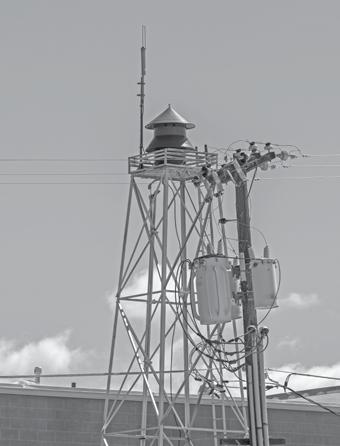

When a park sprinkler activated just as the protest began, the group had to suddenly move to a different spot. That new location afforded Meeden a view of the alley behind the downtown businesses.
“That’s when the impact really hit me,” Meeden said. “That’s where these atrocities would take place. People would be threatened with arrest, beaten
and taunted. They couldn’t be on the main street, and had to take refuge on that alleyway. I wondered how many people had to hide or seek refuge back in there.”
Prior protests have drawn a small number of siren supporters though none appeared or spoke at the Minden Park event. Frisby did not respond to a request for comment.
However, the runners were surprised to encounter a siren defender on their course. “We’re trying to shut down the siren, it represents a lot of bad things,” Stevens told him. In response, the man said he considered the issue “a small problem compared to the real world,” and encouraged the runners to “live in the now.”
The man’s comments felt like “a slap in the face,” Stevens said.
“People think that racism and history and all of it has been taught and learned and digested already, and that everybody is over it, but people like that show that it’s not,” Stevens said. “These kinds of events are needed for people to interact and connect with other people
who feel differently than them.”
Though just 18 years old, Stevens has already taken action to educate the public about Indigenous issues by highlighting the life of his greatgrandfather. Government officials forced Indigenous children like Frank Quinn to leave their homes for distant boarding schools in the early 1900s. Only eight years old, Quinn escaped Stewart Indian School by running 50 miles through the desert back to his Paiute reservation home, not once but three times.
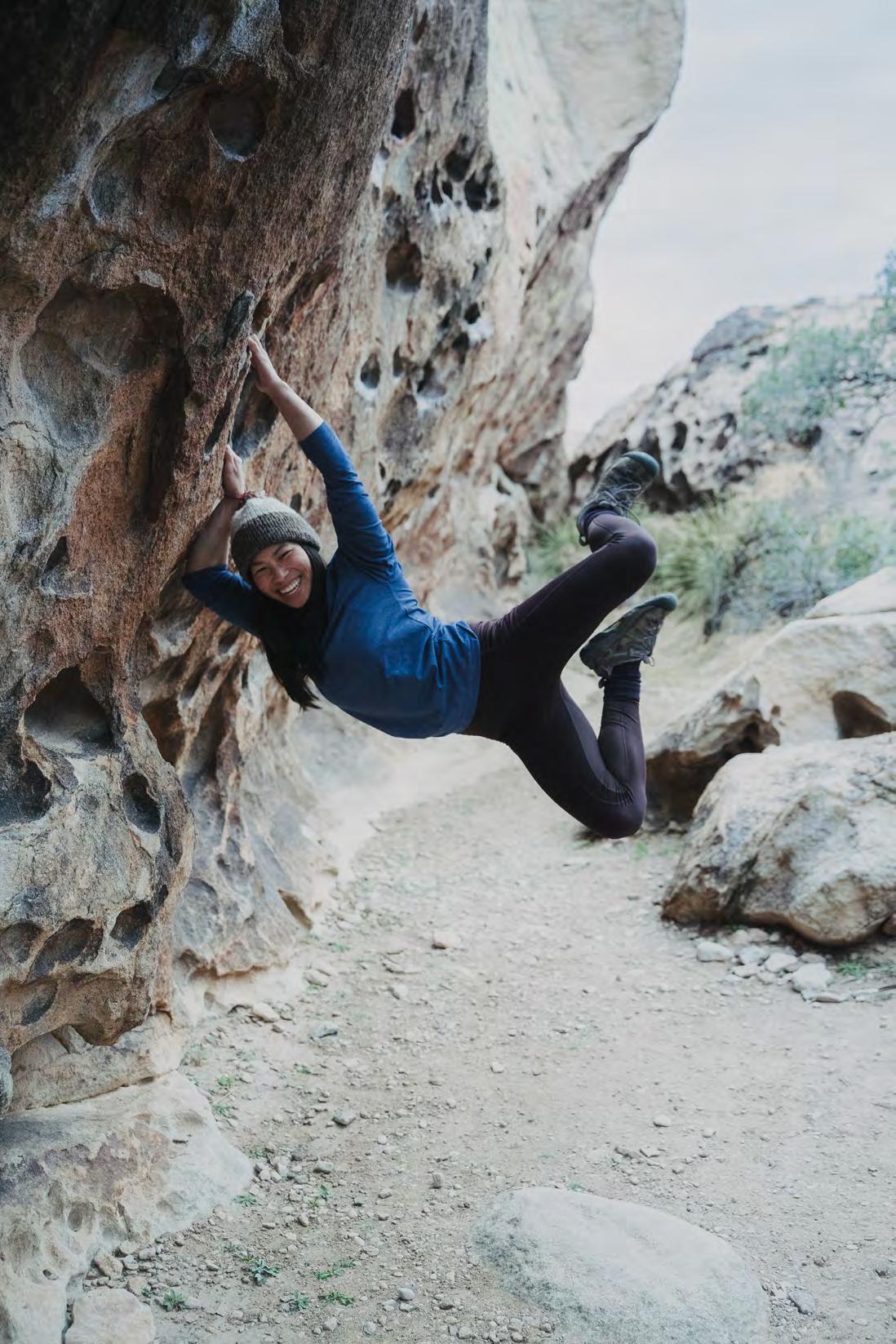
To honor his great-grandfather, Stevens organized a Remembrance Run along the same 50-mile route in 2021, and plans to repeat the event twice more to match Quinn’s three runs to freedom. Indigenous issues like the siren, boarding schools and missing people all interlink, he noted.

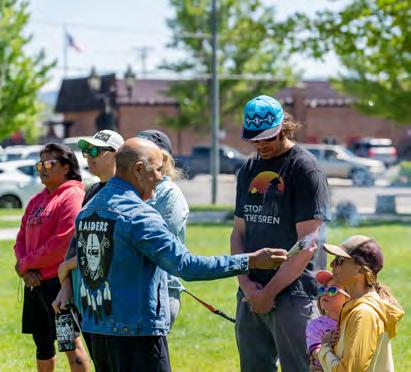
After the May 29 run, weary siren opponents rehydrated, congratulated each other and vowed to meet again next year. Shortly after they dispersed, the Minden siren sounded again at 5pm.

“We have a long way to go,” Stevens said.
The Siren Run will take place Memorial Day weekend 2023, check ridersagainstracism. org/siren-run for updates. The efforts to stop the Minden siren will also be the subject of a new podcast series called The Sum Of Us by best-selling author Heather McGhee, Higher Ground and Futuro Studios. The Minden siren episode is scheduled to be released in September. Find it on spotify.com. The Stevens family will be hosting the Remembrance Run this year, August 13th and 14th, to raise awareness about the legacy of boarding schools. For more info on the Stevens family and the run, check out remainingnativedocumentary.com.
“It was nice having people to run with behind me, to hear their footsteps, to know that they’re here for the same reason I’m here. In a way, that was special. Hopefully people will listen to the meaning behind the run.”
Go to the EVENTS page on our website for more information and direct links to events. CONFIRM DATES AND DETAILS WITH EVENT PRODUCERS.
6 — Marin Century / Marin Fairgrounds / 6 routes / MarinCyclists.com
6 — Tour de Big Bear / Bear Mountain Resort / BigBearCycling.com
27-28 — Northstar Enduro / Truckee / CaliforniaEnduroSeries.com
10 — Race the Rails / Ely, Nevada / Mountain bikers and road bikers race the train / 25 miles / ElyNevada.net/ race-the-rail
10 - 17 — California Coast Classic / SF to LA / Fully supported / Ride iconic Highway 1 at your own pace / Use code ADVENTURE for $25 off / Events. Arthritis.org
11 — Tour de Tahoe - Bike Big Blue / Lake Tahoe / 72-mile course circumnaviagates the highways around Lake Tahoe / BikeTheWest.com
16-18 — Silver State 508 / Reno, NV / the508.net
17 — Mammoth Tuff / Mammoth / Gravel / MammothTuff.com
17 — Tour of the Unknown Coast / Humboldt County / TUCcycle.org
24 — Wine and Roses / Paso Robles / WineAndRosesRide.com
25 - Oct 1 — OATBRAN (One Awesome Tour Bike Ride Across Nevada / Lake Tahoe to Baker, NV / Epic cycling journey across Nevada / BikeTheWest.com
1 — Ashland Mountain Challenge / Ashland / Enduro / Finale for CES / CaliforniaEnduroSeries.com
1 — Hardman Classic / Anaheim / Mixed terrain / HardmanRaceSeries.com
1-2 — Usal Lost Coast / Mendo. Cty. / GrasshopperAdventureSeries.com
2 — Tour de Cure: Wine Country / Rohnert Park / Tour.Diabetes.org
15 — Hammer Road Rally / Shaver Lake / BikeMonkey.net
29 — Filthy 50+ / San Diego / 50+ & 30 Mile Rides / Kids Ride / All Levels / QuickNDirtyMTB.com
6 — Twilight Trail Adventure / Auburn / NorCalUltras.com
13 - 14 — Remembrance Run / Yerington Paiute Tribe / Hosted by runner Kutoven Stevens / In honor of the children who survived Indian boarding schools / 50 miles in two days / fb.me/e/1XWTYJ5yU
28 — Good Dog - Dirty Dog 5K/10K / Folsom SRA / TotalBodyFitness.com
3 — Beach Dash / Long Beach / 5K, 10K, 15K, and half marathon / ABetterWorldRunning.com
11 — Buffalo Stampede / Sacramento / BuffaloStampedeRun.com
17 — Take it to the Lake Half Marathon, 10 K & Kids Fun Run / Ely, NV / ElyNevada.net

24 — Gold Rush Growler 10 Mile & 5K Trail Runs / Granite Beach / TotalBodyFitness.com
1-2 — Urban Cow Half Marathon, Relay & 5K Run/Walk / Sacramento / UrbanCowHalf.com
8 — Ruth Anderson Memorial Endurance Run / Lake Merced, San Francisco / UltraSignUp.com
8-9 — United Airlines Rock ‘n’ Roll San Jose / San Jose / RunRocknRoll. com/san-jose
9 — Humboldt Redwoods Marathon / Weott / Marathon, Half, 5K / RedwoodsMarathon.org
16 — Wahine 10K / 6K / Santa Cruz & Capitola / Coastal courses / Breathtaking scenery / Beachfront finish with music and celebration / RunSurfersPath.com
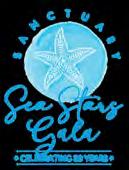
5 — Alcatraz Invitational / San Francisco / 1.27mi open water swim / From Alcatraz Island to Aquatic Park Beach / Views of the city, Golden Gate Bridge and Bay Bridge in the distance / SERC.com/alcatraz-invitational
7 — Tri Santa Cruz / Santa Cruz / Sprint and olympic distances / Triathlon, aquabike, duathlon, aquathlon and relays / FinishLineProduction.com
13 — Sky High Tri / Ely, NV / Triathlon, duathlon, relay / Sprint, beginners & kids / ElyOutdoorEnthusiasts.org
14 — Hermosa Beach Triathlon / Hermosa Beach / All skill levels / HermosaBeachTri.com

27 — Granite Bay Triathlon / Folsom Lake / TotalBodyFitness.com
27-28 — Santa Barbara Triathlon & Multisport Festival / Santa Barbara / SantaBarbaraTriathlon.com

11 — Ironman 70.3 Santa Cruz / Santa Cruz / Ironman.com
17-18 — Malibu Triathlon / Malibu / MalibuTri.com
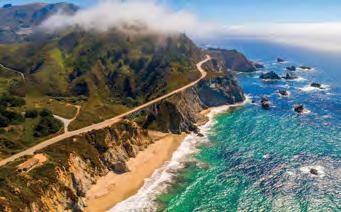
18 — Pacific Coast Triathlon/ Duathlon / Crystal Cove State Beach / OCTriSeries.com
25 — XTERRA Laguna Beach / Laguna Beach / XTERRALagunaBeach.com
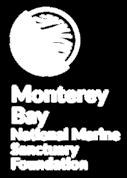
25 — Santa Cruz Triathlon / Santa Cruz / SantaCruzTriathlon.org
1 — T9 Mermaid Tri & Du / Capitola / International Tri, Sprint Tri, Sprint Du / MermaidSeries.com
23 — San Diego Triathlon Challenge / San Diego / ChallengedAthletes.org
Various Dates / Adventure Van Expo / Various dates & locations — Sept.

3-4 Bend (Redmond), OR / Sept. 1718 Lake Tahoe / Oct. 15-16 Big Bear / Open house vans, 4X4 rigs and gear / Demos and workshops / Music, food and camping / See ad on page 29 / AdventureVanExpo.com
September 21 - 25 / Yosemite Facelift / Yosemite / In person and virtual options / Pick up litter and engage in service projects / Largest cleanup of a national park / For more information about this special event, see the article on page 26 / YosemiteFacelift.com
HOKA describes the Bondi 7 as an “ultra-cushioned game-changer” and we couldn’t agree more. They’ve taken an already spectacular shoe and updated it with a plush memory foam collar that’s designed to fit a more narrow heel as well as a wide variety of ankle sizes.
The Bondi 7 retains its predecessor’s signature Meta-Rocker technology, full-length EVA midsole, and breathable open mesh upper. Its supportive, soft cushion all but eliminates impact for a singularly comfortable ride.
We love that this running shoe is vegan and made from recycled materials, plus it comes in a variety of inspiring colorways.
MSRP: $160.00 • hoka.com
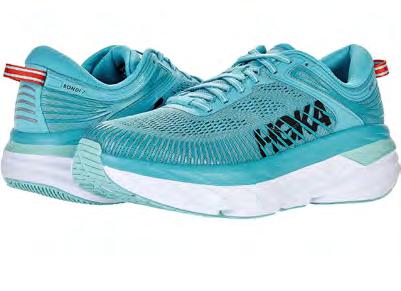

Whether you’re jonesing for something chilly on a hot adventure (ice cream! for real!) or something hot (mmm, soup) on a chilly one, Klean Kanteen has you covered with their double-wall vacuum insulated food canisters.
Choose from a range of different sizes (8-, 16- and 32-ounce), or opt for all three as a complete set. Each canister features Klean Kanteen’s evolutionary TK Closure™ internal thread design for the very best thermal performance as well as a newly designed bowl-shaped base.
Crafted from food-grade stainless steel with electro polished interiors, the TKCanister won’t retain or impart flavors. Its wide mouth design allows for easy eating, filling, and cleaning. A leakproof lid locks with a simple quarter turn and includes a swivel loop for an easy carry.

Dishwasher safe, stackable, and packable, Klean Kanteen food canisters are a must-have for any and all adventures.
MSRP: $29.95-$104.85 • kleankanteen. com

No matter what kind of adventure you’re heading out on and in which season, be sure to pack BUFF®’s Merino Lightweight Neckwear.
This lightweight, versatile tube is designed to provide comfort and protection for your neck, but we love how it pulls multi-duty on backpacking trips as a pillow case (slip it around your tent bag stuffed with your puffy and extra clothes); a beanie (twist one end, pull inside out and slip it down over your head, folding at the rim as needed); and even an eye-mask (simply throw over your face) on those full-moon nights.

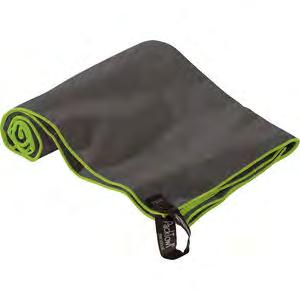
The Merino Lightweight Neckwear is eco-friendly as it’s made of 100% Merino wool sourced from humanely raised, non-mulesed sheep. Naturally moisture-wicking and odor-controlling, it’s also wind-resistant, soft and stretchy.
At BUFF®’s lightest Merino range – 125 g/m² –the Merino Lightweight Neckwear is just the right balance of warmth and lightness just about any time of the year. Comes in a variety of colors and patterns.
MSRP: $29.00 • buff.com



Outstandingly absorbent, uber quick to dry, soft and smooth, totally packable – the PackTowl Personal Towel checks all the boxes and then some. This versatile towel is perfect for just about any activity, indoors or out. Take it camping, swimming, paddling, working out, traveling … heck, it even works great as your regular ole shower towel at home!
Soaking up four times its weight in water, the Personal Towel wrings out easily and dries nearly 70% faster than cotton towels. What’s more, Polygiene® odor control helps to keep the microfiber fabric smelling fresh, and its hanging loop and storage pouch make it easy to dry and pack. The PackTowl Personal Towel comes in a wide variety of colors and prints. Choose from face, hand, body and beach sizes.
MSRP: $12.95-$44.95 • packtowl.com
Newly released by our innovative friends over at Kula Cloth is the Kula Wilderness Potty Kit, an all-in-one kit for doing your biz out in the wilds.
The kit includes Kula’s brand spankin’ new and first-of-its-kind Kula Pocket Waterproof Antimicrobial Bag designed specifically for storing your hygiene items while on adventure. This wellthought-out bag is designed with silver-infused antimicrobial absorbent lining and the reflective webbing on the attachment loop makes it easy to find by headlamp at night.
Now, for the all cool stuff you can store inside this snazzy Kula Pocket: the kit includes a Personal Urination Device (pee funnel), an ultralight trowel, and a itty bitty Nalgene bottle for soap.
Top that all off with a limited addition Kula Cloth and voila … pottying in the forest has never been so simple and organized. Weighing in at a mere 4.4-ish ounces, this set is easy to pack along on any adventure.
MSRP: $72.50 • kulacloth.com
Tent camping with the fam has never been so easy and comfortable. Spacious and durable, the Zempire Evo TL V2 inflatable tent was designed to be set up quickly, so you can get straight to relaxing and adventuring.
The Evo TL V2 boasts a full head-height living room and multiple sleeping areas, so your family will feel right at home on those extended getaways. Multiple ventilation points ensure excellent airflow, while configurable inner walls and tinted windows offer privacy throughout. This queen of all tents also features TPU tape–sealed seams to help keep moisture at bay, plus UV and fire-retardant fabric treatments for extra protection. Its SeroLink™ frame system offers rigid, angled beam construction to maximize head room, and attaches the air frame directly to the fly to keep weight and bulk to a minimum.
In addition to the innovative and roomy indoor space, the Evo TL V2 includes a covered front “patio” — great for relaxing after a day of exploration or as a protected entryway to the main living area. A double-action pump with pressure gauge and pressure release valve is included, along with a haul bag and emergency repair kit.
Sleeps 4 comfortably; 5 maximum.
MSRP: $1,999.00 • zempirecamping.com


